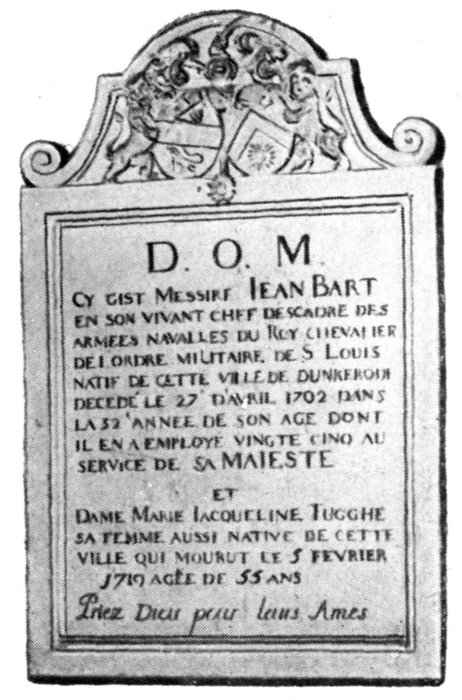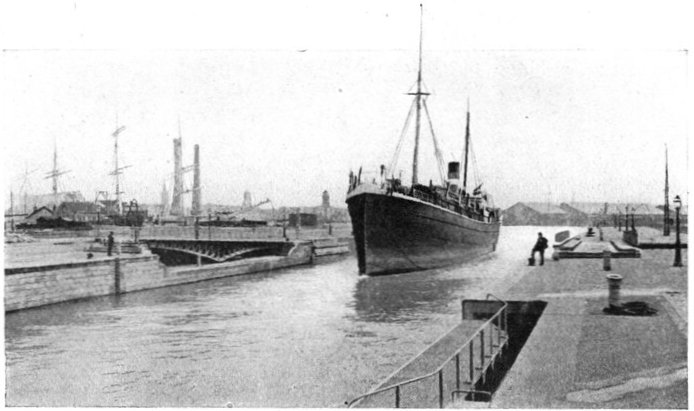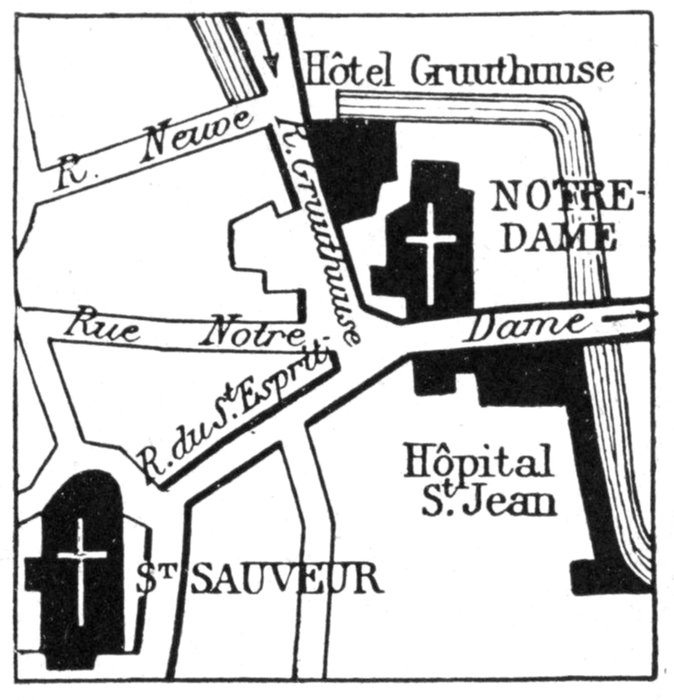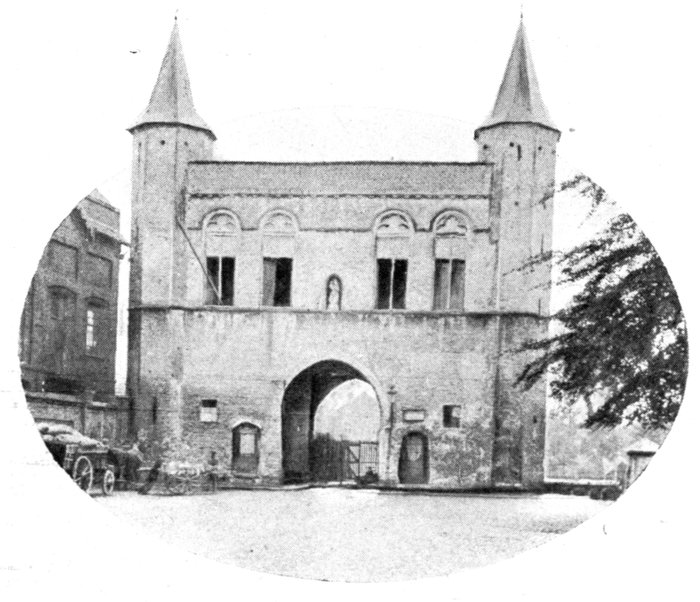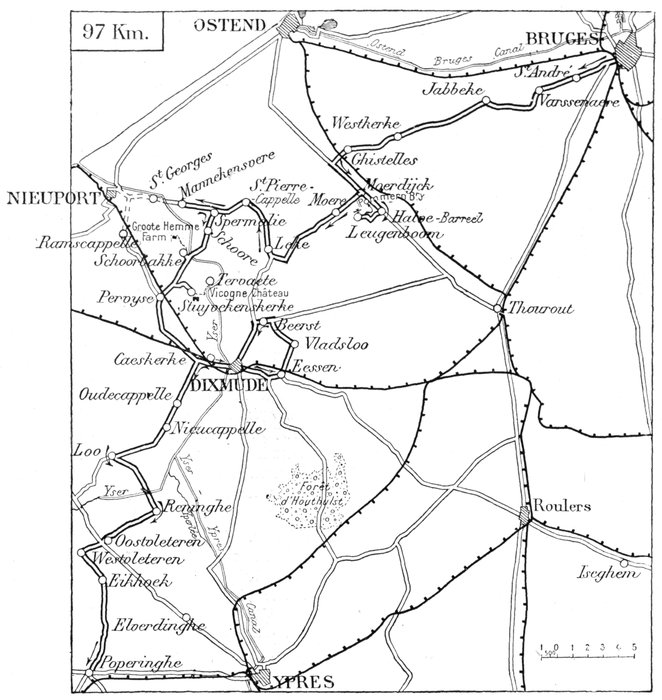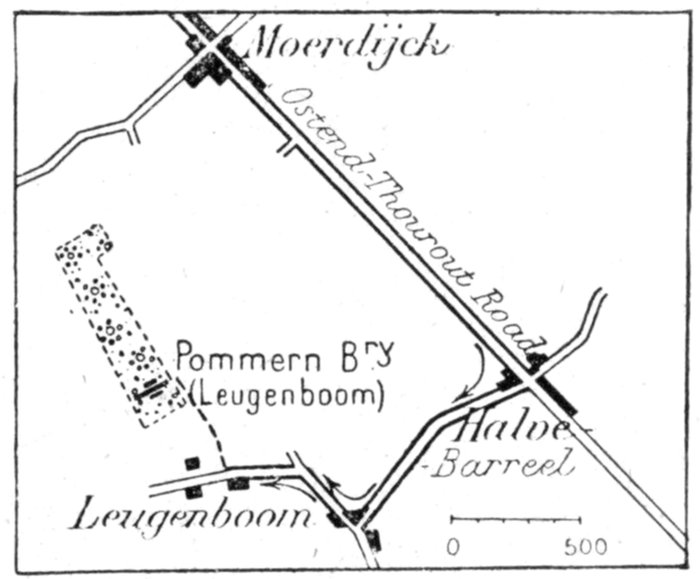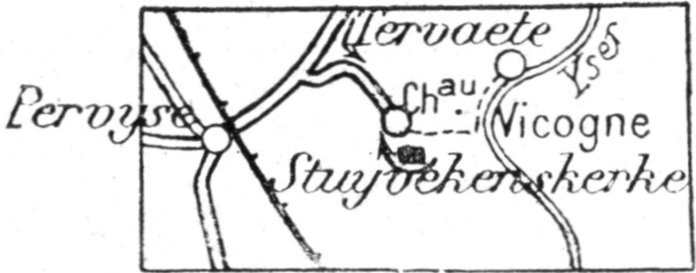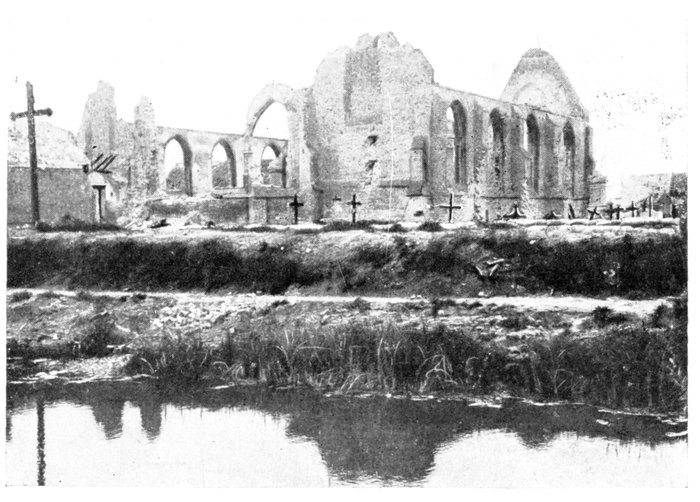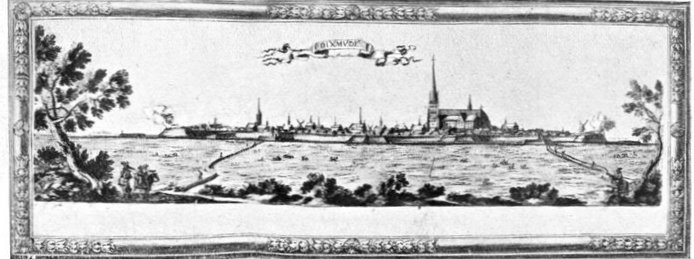The cover image was created by the transcriber and is placed in the public domain.
[Pg i]
MICHELIN ILLUSTRATED GUIDES
TO THE BATTLEFIELDS (1914-1918)
THE
YSER
AND
THE BELGIAN COAST
An illustrated
history
and guide
- MICHELIN & Cie, CLERMONT-FERRAND, FRANCE.
- MICHELIN TYRE Co., Ltd., 81, Fulham Road, LONDON, S. W. 3.
- MICHELIN TIRE Co., MILLTOWN, N. J., U. S. A.
Michelin gives all profits from the sales of the present guides to the "Repopulation française" (Alliance Nationale)
10, Rue Vivienne.—PARIS.
[Pg ii]
HOTELS
BRUGES

- Hôtel de Flandre, 38, rue Nord-du-Sablon. Tel. 19.
- Grand Hôtel et du Commerce, 39, rue Saint-Jacques. Tel. 114.
- Hôtel du Sablon, 21, rue Nord-du-Sablon.
- Hôtel du Panier d'Or, Grand'Place.
DUNKIRK

- Hôtel des Arcades, 37, place Jean-Bart,
 Arcades. Tel. 1·89.
Arcades. Tel. 1·89.
- Hôtel du Chapeau-Rouge, de Flandre,
et Grand-Hôtel réunis, 5. rue Saint-Sébastien,
Tel. 2·15.
OSTEND

-
Royal Palace-Hôtel, Digue de Mer,
Tel. 173, 435 et 271.
- Hôtel Continental, Digue de Mer,
63, & rue de l'Yser. Tel. 154.
- Splendid-Hôtel, 67, rue Royale &
Digue de Mer. Tel. 13.
- Hôtel de la Plage, 65, Digue de
Mer & r. Royale. Tel. 152 et 593.
- Hôtel Kursaal et Beau-Site, 40, Digue
de Mer. Tel. 121.
- Hôtel de la Couronne, 17, quai de
l'Empereur. Tel. 43.
- Rouget's Hôtel Beau-Séjour, 110-112,
boul. Van Iseghem. Tel. 504.
- Helvétia-Hôtel, 62, Digue de Mer.
Tel. 200.
- Hôtel Wellington, 60, Digue de Mer

- Hôtel Alberta 31, Rampe de Flandre.
POPERINGHE.—Skindles-Hôtel, 43, rue de l'Hôpital. Tel. 24.
ZEEBRUGGE.—Zeebrugge-Palace. Tel. 6, Heyst.
[Pg iii]

AN INDISPENSABLE AUXILIARY
The Michelin Map
On sale
at booksellers
and
MICHELIN
stockists.
For the
present
GUIDE
take sheet
no 1.
MOTORISTS
this map
was made
specially
for you.
[Pg iv]
The "Michelin Wheel"
BEST of all detachable wheels
because the least complicated
Smart
It embellishes even the finest coachwork.
Simple
It is detachable at the hub and fixed by six
bolts only.
Strong
The only wheel which held out on all fronts
during the War.
Practical
Can be replaced in 3 minutes by anybody
and cleaned still quicker.
It prolongs the life of tyres by cooling them.
AND THE CHEAPEST
[Pg 1]
IN MEMORY
OF THE MICHELIN WORKMEN AND EMPLOYEES WHO DIED GLORIOUSLY
FOR THEIR COUNTRY
THE
YSER
AND THE
BELGIAN COAST
Ce n'est qu'un bout de sol dans l'infini du monde...
Ce n'est qu'un bout de sol étroit,
Mais qui renferme encore et sa reine et son roi,
Et l'amour condensé d'un peuple qui les aime...
Dixmude et ses remparts. Nieuport et ses canaux,
Et Furnes, avec sa tour pareille à un flambeau.
Vivent encore ou sont défunts sous la mitraille.
Émile Verhaeren.
Compiled and published by:
MICHELIN ET CIE
Clermont-Ferrand (France)
All rights of translation, adaptation or reproduction (in part or whole) reserved in all countries.
CONTENTS
[Pg 2]
The Race to the Sea.

King Albert and General Joffre.
In September 1914, after the Battle of the Marne and the German retreat,
the centre and right of the French Armies quickly became fixed in front of
the lines which the enemy had prepared in the rear, and were then fortifying.
While the Allies' right, abutting
on the Swiss frontier, was protected
against any turning movement
on the part of the enemy, their left
(the 6th Army) was exposed.
The French 6th Army (General
Maunoury) held the right bank of
the Oise, north of Compiègne (See
map p. 3). The Germans attacked it
in force and attempted their favourite
turning movement.
General Joffre parried the manœuvre,
and while strengthening the 6th
Army, formed a mobile corps on his
left wing, strong enough to withstand
the enemy's outflanking movement.
The 2nd Army, consisting of corps
brought up from the east, was formed
and placed under the command of
General de Castelnau. Preceded and
protected by divisions of cavalry, it
gradually extended its front to the
south of Arras.

Queen Elizabeth in the Belgian
Lines, on the Yser
The Germans carried out a similar
movement, and the opposing armies,
in their attempt to outflank each
other, gradually prolonged their
front northwards and approached
the sea.
Against the German right wing,
which steadily extended itself northwards,
General de Maud'huy's Army
deployed from the Somme to La
Bassée, and gave battle in front of
Arras.
The Germans attacked furiously
and attempted both to crush the
Allied front and continue their
turning movement. Six Army Corps
and two Cavalry Corps were thrown
against General de Maud'huy's Army
but the latter, reinforced, held its
ground.
The command of the Northern
Army Group was entrusted to General
Foch.
The new chief promptly co-ordinated
the dispositions, in view of a
general action.
[Pg 3]
The northward movement of the armies became more pronounced. The
cavalry divisions of the Corps commanded by Generals de Mitry and
Conneau advanced towards the Plains of Flanders.
Simultaneously, the British Army was relieved on the Aisne, and drew
nearer to their threatened coast bases, in the region of Saint-Omer.
By October 19, they were completely installed in their new positions from
La Bassée to Ypres, thus prolonging northwards the Army of General de
Maud'huy. Between the British left and the North Sea Coast, there still
remained a gap, crossed from west to east by the roads leading to the
Channel Ports. It was this gap which the Belgian Army, after its escape
from Antwerp, was destined to stop.
[Pg 4]
The fall of Antwerp and the Belgian retreat.
To capture Antwerp, the Germans adopted their usual tactics. Concentrating
their powerful siege artillery—which had previously destroyed the
forts of Liége, Namur and Maubeuge—in the sector south of the Nethe, they
effected a breach in the outer line of forts, and having crossed the Nethe,
with a loss of nearly 50,000 men, they attacked the inner line of forts, so as
to be able to bombard and reduce the town.
After consultation with the French General Staff, it was decided to abandon
the town, in order to save the Belgian Army.
Leaving a small number of troops in the forts, with orders to mask the
evacuation of the town, the Belgian Army, after destroying everything
likely to be of use to the enemy, crossed the Escaut by night, together with
the British forces, which, as early as September, had been despatched
to help in defending the city. These troops withdrew westward, via
St. Nicolas and Ecloo. On October 9, Antwerp capitulated.
To protect the flank of the columns retreating towards Bruges, the French
Marine Brigade, a detachment of Belgian Cavalry and volunteers, and the
British 7th Division took up positions in front of the eastern outskirts
of Ghent.
On October 4, Admiral Ronarc'h who had meanwhile concentrated his
brigade in the entrenched camp of Paris, received orders to transfer his
quarters to Dunkirk. Leaving St. Denis on the 7th, accompanied by his
staff, and closely followed by the Brigade, he reached Dunkirk in the evening,
proceeding thence to Antwerp. On the evening of the 8th, they were met
at the railway station of Ghent by General Pau with orders to defend that
town.
The Marines took up positions east of Ghent, and to the north and
south of Melle. Belgian volunteers occupied the bend in the Escaut. These
troops were supported by a group of Belgian artillery belonging to the
4th Mixed Brigade.
The Germans violently attacked in greatly superior numbers along the
Alost-Ghent road, but for forty-eight hours the Marines carried out their
mission of flank-guard. On receiving orders to retreat, the Franco-Belgian
detachment, covered by units of the British 7th Division, re-crossed the
Escaut and fell back towards the Yser, via Thourout, where the Belgian
Army was arriving, closely followed by detachments of German cavalry.
[Pg 5]

Cavalry on the beach at Malo-les-bains.
(Note the barbed-wire entanglements.)
The Battlefield.
The last strip of unconquered Belgian territory, on which the German thrust
was destined to be broken, forms part of Maritime Flanders (See map, p. 6).
This vast plain was formerly a sea-gulf, and as late as the 11th century, was
often raided by the "drakkers" of the Scandinavian pirates. In the Middle-Ages,
the gulf gradually filled up with sand. This vast polder is almost
entirely below sea-level at high tide, and is each day invaded by the waves.
Water is everywhere: in the air, on the ground, under the ground.
It is the land of dampness, the kingdom of water. It rains three days out of four.
The north-west winds, breaking off the tops of the stunted trees, making
them bend as if with age, carry heavy clouds of cold rain formed in the open sea.
As soon as the rain ceases to fall, thick white mists rise from the ground, giving
a ghost-like appearance to men and things alike. (Le Goffic's, "Dixmude").

Line of Defence near Noordschote.
[Pg 6]
Water, which oozes up out of the soil, giving a blister-like appearance to
the soft clay covering, is found at a depth of less than three feet.
This water was carefully drained off, under the control of the Belgian State,
by associations of farmers and land-owners ("gardes wateringues"). Countless
ditches and canals ("watergands") skirting the willow hedges and
intersecting the entire plain, carried away this surplus water.
All the canals and ditches communicate with numerous water-courses,
e.g. the Yperlée, Kemmelbeck, Berteartaart, Vliet and many other nameless
ones, which run between embankments into the Yser.
[Pg 7]

The road from Furnes to Ypres, near Westvleteren, in December 1915.
(See page 127.)
The Yser, a small coastal river, having its source in French Flanders
empties itself into the sea between two jetties. Its shallow bed, dredged
along the greater part of its course, describes a wide semi-circle. At its
mouth, at Nieuport, the Yser and the canals which likewise end there, are
closed by a series of locks, which shut out the sea at high tide and prevent
it from invading the plain through the streams and canals.
The few roads and the Nieuport-Dixmude railway run along embankments
seven to ten feet high.
Formerly, flocks of sheep and herds of cattle, tended by grey-coated
shepherds, grazed in this plain. Immense fields of beet and turnips
alternated with the meadows. Hedges, willows, clusters of bending poplars,
and the roofs of the low farmsteads built on little hillocks, broke the monotony
of the landscape. Here, where peace and prosperity reigned, the
inundations and war have left a vast expanse of reeds, in which the roads,
ruined farmhouses and a few broken trees stand out dismally.
The plain is bounded on the west by a line of wind-formed sand dunes
planted with oyats. These dunes extend along the straight unbroken coast.
To the east of Dixmude rises a series of heights, which, marking the beginning
of the solid ground, are continued further east by the long unbroken
crest of Clerken.
South of this crest stretches the Forest of Houthulst, now entirely devastated
by shellfire.
The spongy nature of the soil makes it impossible to excavate to any
depth, nor was there any high ground to mask the defence-works and
batteries of artillery.
Two great embankments: that of the Yser, arc-shaped, and that of the
Nieuport-Dixmude railway, connecting up to the two ends of the former,
were the framework of the defence lines. However, the dominating element:
water, provided the defenders with a supreme and irresistible arm.
[Pg 8]
The Opposing Forces.
The right wing of the German IVth Army, under the command of the Prince
of Württemberg, marched via Bruges towards Dunkirk. This newly formed
army was partly composed of young men belonging to the German aristocracy,
volunteers and former students, worked up to frenzied patriotism by
the German victories.
These admirably equipped troops were supported by at least 500 guns of
all calibres, to which was soon added the heavy siege artillery that had just
crushed the forts of Antwerp.
This mass of 160,000 men, drunk with the furor teutonicus, pursued its
victorious march on the Channel ports, certain of crushing the small Belgian
Army which had again escaped them at Antwerp, but which this time was
to be annihilated.
Without losing a single gun during their stirring retreat, the Belgian
Army reached the Yser line. In its death-grapple with the invader, it
had been seriously reduced by more than two months of hard fighting.
Minus the greater part of its officers, and reduced to 43,000 rifles, 300 75's
and 23 6in. howitzers, its reserves of munitions were barely sufficient to deliver
another battle. There was no hope of new supplies, as the army was deprived
of its arsenals.
The men, with their torn and muddy uniforms, seemed to have reached
the limits of physical endurance, and to be incapable of further prolonged
effort.
It was then that King Albert issued his stirring Order of the Day:
Soldiers,
For two months and more you have been fighting for the most just of causes:
your homes and national independence.
You have held the enemy's armies, sustained three sieges, executed several
sorties, and successfully carried out a long retreat through a narrow defile.
So far, you have been alone in this tremendous struggle. Now you are at
the side of the valiant French and British Armies.
It is your duty to uphold the reputation of our arms with that spirit of tenacity
and bravery of which you have given so many proofs. Our national honour is
at stake.
Soldiers,
Look on the future with confidence, and fight with courage.
In whatever positions I place you, look ahead, and consider as a traitor to the
Motherland whoever speaks of retreat, without the formal order having been
given.
The time has come for us, with the aid of our powerful allies, to drive the
enemy from our dear country, which they invaded in contempt of their word and
of the sacred rights of a free people.
(Signed) Albert.
The supreme battle was about to begin. To hold the enemy's thrust
against Dunkirk and Calais, the Belgian Army, supported by the Allies, once
again resolutely placed itself across his path and barred the way.
From the sea to Zuydschoote (8 km. North of Ypres), the Belgian Army
was at first obliged, with the help of only 6,000 French Marines, to hold a
twenty-two mile front.
[Pg 9]
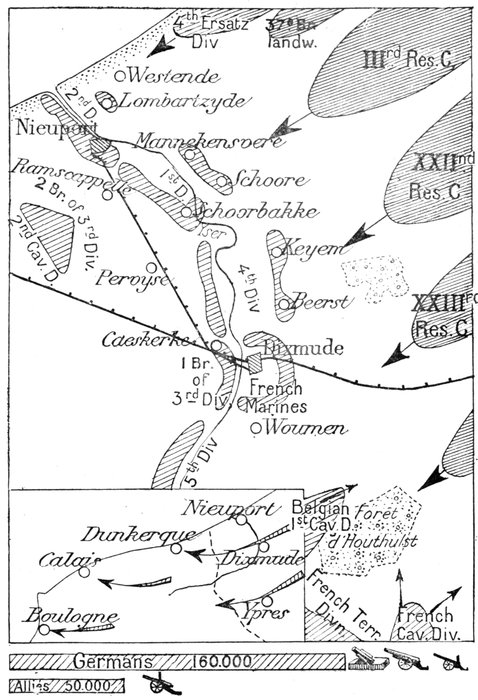
The unequal strength of the opposing forces seemed to warrant
the enemy's expectations of crushing in the Allied front and breaking through to
the Channel ports.
To defend this wide front, the whole Army was deployed. From the coast
to Dixmude, the 2nd, 1st and 4th Divisions were echeloned, with units
beyond the Yser holding the advance-posts of Lombartzyde, Mannekensvere,
Schoore, Keyem, Beerst and the two bridgeheads of Nieuport and Schoorbakke.
The bridgehead of Dixmude was held by the brigade of French Marines and
a brigade of the Belgian 3rd Division. South of Dixmude, the 5th Division,
in positions along the canalised portion of the Yperlée, occupied the region of
Boesinghe in liaison, on the right, with divisions of Brittany Territorials.
The 1st Division of Belgian cavalry operated near the woods of Houthulst
and Roulers, with French Cavalry divisions of General de Mitry's 2nd Corps,
thus protecting the Belgian right.
There remained in reserve only two Brigades of the 3rd Division and
2nd Cavalry Division to the south-west of Nieuport.
[Pg 10]
THE BATTLE OF THE YSER.
The fighting in the advance-positions.
The Franco-Belgian troops had hardly taken up their defensive positions
when, on October 15, the guns began to roar in the direction of Dixmude.
On October 16 and 17, strong German reconnoitering parties, supported by
field artillery, came into contact with the Allies' positions.
On the 18th, the enemy hurriedly attempted to crush the defenders,
before reinforcements arrived. After a violent bombardment, a powerful
attack was launched against the Mannekensvere-Schoore-Keyem-Beerst
line, held by units of the Belgian 2nd, 1st and 4th Divisions.
Assault after assault was beaten off, but finally, after very heavy losses,
fresh enemy masses carried Mannekensvere and Keyem, where they were
held by the volley fire of the Belgian 75's. The defenders of Mannekensvere
withdrew behind the Yser, while those of Keyem (units of the 1st Division)
held their ground on the
right bank of the river. The
same night a spirited counter-attack
gave them back
their lost positions.
On the 19th, the attacks
doubled in fury, the enemy's
main effort being made
against the two wings.
Nieuport and the advanced
lines of Lombartzyde
were violently bombarded.
The Belgian 2nd Division
stood firm, and beat off
three German assaults.
On the right wing, the
Germans, driven out of
Keyem on the previous day,
attacked this village again
and also Beerst, further
south. Under a terrific
artillery fire, the defenders
gave way.
However, the Belgian 5th
Division and the French
Marines debouching from Dixmude, captured Vladsloo and Beerst, in spite
of considerable losses. With their left threatened, the enemy's efforts before
Keyem weakened.
This brilliant counter-offensive was held by a new menace. Strong
enemy columns were signalled to the south-east, debouching from Roulers
and marching on Dixmude.
The 5th Division and the Marines fell back upon their original positions
before Dixmude, their retreat bringing about the fall of Beerst and Keyem,
whose defenders withdrew beyond the Yser.
On the 20th the Germans threw themselves against the advanced positions
of Lombartzyde. The defenders were supported by the artillery of the
British monitors, whose guns swept the coastline. To the south-east of
Lombartzyde, Groote-Bamburg Farm was first lost, then reoccupied after
a spirited counter-attack.
The Germans redoubled their costly efforts, and succeeded in getting a
footing in Lombartzyde in the evening, but were unable to debouch.
[Pg 11]
Only after five days of sanguinary fighting, were the enemy able to reach
the Allies' main line of defences, formed by the Yser and the two bridgeheads
of Nieuport and Dixmude.
The Battle on the Main Line of Defence.
The situation was none the less critical, and the battle waxed more and
more furious. The Yser front was continuously deluged with shells. The
Belgian batteries of 75's were unable to engage the German heavy guns.
None of the villages could be held; Nieuport and Dixmude were in flames.
Supported by the Brigade of French Marines, the remains of the six Belgian
Divisions still defended, single-handed, the twelve-mile front between
St. Jacques-Cappelle and the sea. They were reinforced by the 6th Division
near Lampernisse and Pervyse, thus strengthening the centre.
Against these depleted, exhausted and ill-revictualled troops, crushed
beneath a continuous bombardment,
the Germans brought
up heavy reinforcements from
Roulers.
The Attack on Dixmude
and Nieuport.
Nieuport and Dixmude formed
the bastions of the Allied
defences, and their capture
meant the falling of the Yser
and the railway lines into the
enemy's hands.
The brunt of the German
attack was directed against
Dixmude.
The French Marine Brigade
and the mixed brigade of the
Belgian 3rd I. D. under the
command of Admiral Ronarc'h,
were deployed in a semi-circle,
about 500 yards from the
outskirts of Dixmude, resting
on the Yser. A second line was established along the canalised river.
On October 20, after an artillery preparation which lasted all the morning,
the enemy made an unsuccessful attack on Dixmude. A fresh attack the
same night was likewise repulsed. Meanwhile the town continued to burn.
On the 21st, at dawn, the bombardment redoubled in violence. The
Germans attacked again, only to be mown down and repulsed.
In the afternoon, new enemy reinforcements delivered converging attacks
of great violence, combining them with a furious thrust against the Schoorbakke
Pass, situated half-way between Dixmude and Nieuport. At both
points the German rush was broken.
In exasperation, the enemy threw fresh battalions into the battle. This
time the blow was aimed directly at the town itself and the canal to the
south, but the defence remained unshaken. Simultaneously, the Germans
were threatening the entire front, and in particular, the bridgehead of
Nieuport. This town suffered the same fate as Dixmude.
Still the Yser remained impassable. Both Dixmude and Nieuport held
out, and the end of the day registered a fresh enemy check.
[Pg 12]
The Breach in the Centre of the Line.
After their failure before Nieuport and Dixmude, the enemy made a
surprise attack against the centre, on the night of the 21st.
Between Nieuport and Dixmude, the easterly loop in the Yser at Tervaete
facilitated flank, enfilade and rear firing, and was consequently a weak
point in the defences.
Under cover of darkness, the enemy threw a bridge over the river, near
Tervaete, and effected a crossing. The situation was critical, as if the
front were pierced, the two centres of resistance, Nieuport and Dixmude,
which until then had proved impregnable, would be taken in the rear.
In a supreme effort, units of the Belgian 1st Division counter-attacked
furiously, and in spite of terrible losses, held the enemy. Reinforcements of
Grenadiers and Carabiniers succeeded, in a further attack, in driving back
the Germans across the river, and in reoccupying their positions. However,
on the night of the 22nd, the enemy recaptured Tervaete, but the Belgians
remained masters of the line
between the two ends of the
loop.
On the 23rd, the situation
was still very critical. To fill
the gaps in the fighting line
and to "hold out to the last, in
spite of all", in accordance with
the orders of the Belgian General
Headquarters, the last reserves
were thrown into the
battle.
Fortunately, the first French
reinforcements,—the famous
"Grossetti" (42nd) Division
which General Foch, at Fère-Champenoise,
in the centre of
the battle-line at the Marne,
had thrown against the flank of
the German columns, thereby
turning the scales at the psychological
moment (See the Michelin
Guide: The Marshes of
St. Gond—part 2 of The First
Battle of the Marne),—arrived at this juncture.
The first units to arrive relieved the exhausted Belgians before Nieuport.
Meanwhile, the bombardment of the town and bridgehead had reached an
incredible degree of violence.
In the centre, the situation was still more serious, the exhausted remnants
of the Belgian 1st and 4th Divisions having reached the limit of endurance.
The enemy threw ten battalions with machine-guns and artillery into the
loop at Tervaete. The bridgehead of Schoorbakke, attacked from the rear
was captured.
On the 24th, the 83rd Brigade of Grossetti's Division was moved to the
centre, to oppose the German thrust, at the time when the enemy had just
carried the Union Bridge.
Encouraged by the advantage which they had just secured, the Germans
renewed their efforts against Dixmude, where their left wing was being held
in check.
They had already gained a footing on the left bank of the Yser, north of
the town, and were threatening to outflank it from the west.
[Pg 13]
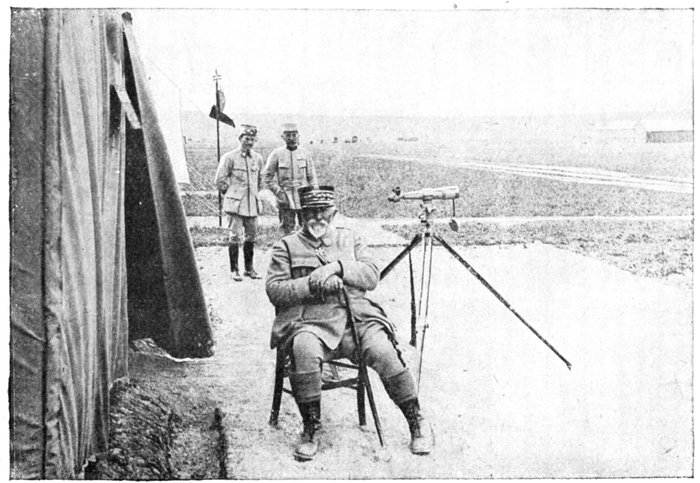
General Grossetti, commanding the 42nd Division.
A supreme effort was made against the bridgehead, no less than fifteen
assaults being delivered on the 24th.
The fierceness and horror of the struggle were indescribable, the men
grappling with one another in pitch darkness.
However, the German furor spent itself against the heroism of the
Belgian Infantry and French Marines who, for more than a week, remained
in the breach day and night.
Dixmude remained inviolate.
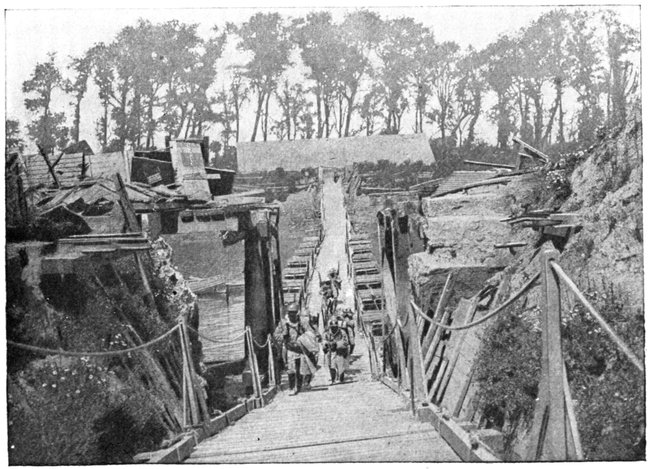
Pontoon Bridge across the Yser.
[Pg 14]
The Inundations.
October 25 brought a pause in the German thrust, the enemy being visibly
exhausted.
But the Belgian Army also was exhausted; many of their 75's were out of
action through intensive firing; scarcely a hundred shells per gun remained.
Would they be able to hold out against another desperate assault?
The General Staff were considering a retreat on Dunkirk—which would
have spelt disaster—when, informed of this by telephone, Foch hurried to the
G. H. Q. where he arrived during a sitting of the War Council. In despair,
the last dispositions for the retreat were being discussed, when in his simple
unaffected way, Foch indicated a line of resistance and suggested inundating
the country. "Inundation formerly saved Holland, and may well save Belgium.
The men will hold out as best they can until the country is under water". (Commandant
Grasset's, "Foch").
To Staff-Captain Nuyten, assisted
by Charles Louis Kogge, a
"wateringue" guard of long experience
and thoroughly acquainted
with the working of the system of
canals and locks, was entrusted the
task of carrying out the plan.
The plain between Dixmude and
Nieuport, being level with the sea,
is protected at Nieuport against
high water by a system of locks
(sketch opposite). The canals and the
Yser are dammed by embankments.
The railway itself runs along a wide
straight dike three to six feet in
height.
Under bombardment, Belgian
Engineers transformed this railway
embankment into a water-tight
dike, by stopping up all the openings
through which the roads
passed and then made wide breaches
in the embankments of the
drainage-canals, so as to allow the water to spread. The whole plain,
between Nieuport and Dixmude was thus transformed into a vast basin
closed on the Belgian side by the railway embankment, the latter being at the
same time organized as a line of resistance.
Certain locks were secretly opened at high-tide, through which the sea
gradually and imperceptibly invaded the basin.
While the sea was thus preparing to play its all important rôle, a fresh
enemy attack forced the Franco-Belgian troops, on the 26th, to withdraw
behind the railway. Orders were given to hold the latter at all cost.
Nieuport and Dixmude were still holding out. At Dixmude, two battalions
of Senegalese relieved the most exhausted units of the defenders.
Behind the railway, units of the 42nd Division and a few battalions of
Territorials supported the desperate efforts of the Belgians.
On the 26th and 27th, while the bombardment continued, the water
began, little by little, to invade the trenches of the enemy, who, however,
did not yet realise the position.
On the 28th, the water began to rise and, on the 29th, spread southwards.
An extremely violent bombardment on the 29th preceded the German[Pg 15]
attacks of the 30th, against the railway. Thanks to their minenwerfer, the
Germans gained a footing on the railway, and advanced as far as the villages
of Ramscappelle and Pervyse. It was a critical moment, the main line
of resistance being pierced.

Fortified Embankment at Ramscappelle.
The defenders pulled themselves together for a last effort, and after a violent
concentration of artillery fire, counter-attacked.
On the 31st, at nightfall, the 42nd Division and Belgian units—remnants
of battalions belonging to the 6th, 7th and 14th line regiments—charged
furiously with the bayonet, to the sound of the bugles. The enemy was
thrown into disorder, Ramscappelle recaptured, and the line re-established.
Imperceptibly but relentlessly the floods invaded the enemy's entrenchments,
turning their retreat into a rout; their dead, wounded, heavy guns,
arms and munitions were swallowed up in the huge swamp. The Battle
of the Yser was over.
The Belgian Army, whose original mission was to hold out for forty-eight
hours, had, with the help of 6,000 French Marines, fought first single-handed,
and then with the support of a single French Division, continued the struggle
until October 31, thus fighting for fifteen days without interruption.

The Allies' Supreme Resource: The Inundations.
[Pg 16]

Belgian
Patrols
on
rafts.
Throughout these 360 hours of deadly strife, the entire Belgian forces had
been in the thick of the battle, without respite. Crouching in their shallow half-formed
trenches, or in the muddy ditches, with no shelters, ill-fed, and fully
exposed to the inclement weather, the men nevertheless stood firm. In their tattered
muddy uniforms, they scarcely looked human. The number of wounded
during the last thirteen days was more than 9,000, that of the killed and missing
over 11,000. The numbers of sick and exhausted ran into hundreds. The
units were reduced to skeletons. The losses in officers were particularly heavy;
in one regiment only six were left.
Thanks to the sacrifices stoically borne, the Belgian Army barred the way to
Dunkirk and Calais; the Allies' left wing was not turned, and the enemy failed
to reach the coast, from which they expected to threaten England in her very vitals.
For the Germans, the battle ended in total and bloody defeat. For Belgium
the name "Yser", which their gallant king caused to be embroidered on the
flags of his heroic regiments, is that of glorious victory. (Comm. Willy Breton).

Building
a
temporary
bridge.
[Pg 17]
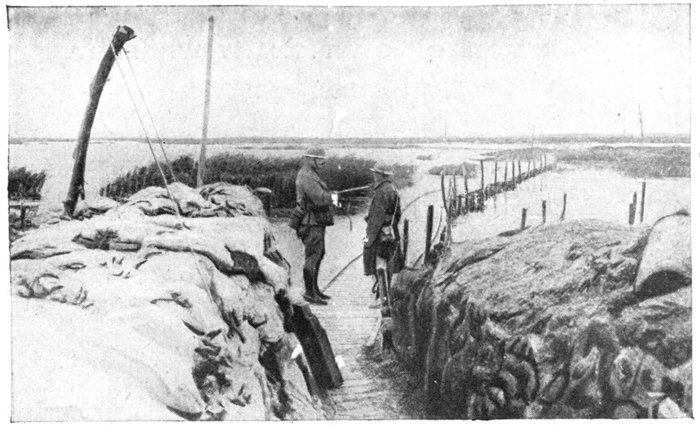
Temporary
Bridges
across the
inundated
Plain.
The fall of Dixmude.
The useless sacrifices on the Yser did not turn the Germans from their
plans for taking Calais.
They now attempted to pierce the Allied front in the neighbouring sector,
between Dixmude and Ypres, where the 87th Territorials, 42nd Division,
(withdrawn from the Yser front), and the 9th Corps strengthened the defences.
On November 9, the bombardment grew more violent. On the 10th,
from Dixmude to Bixschoote, along the whole of the canalised Yser and
the Yser-Ypres canal, huge masses of enemy troops attacked in deep column
formation.
After prolonged sanguinary street fighting, in which the French Marine
Brigade again distinguished itself, Dixmude succumbed. The Germans
were, however, unable to cross the Yser, and the respective front lines
became fixed on the canal embankments. The battle spread eastwards,
around the salient of Ypres (See the Michelin Guide: "Ypres and the Battles
of Ypres".)

The Cloth Hall at Ypres, in 1919.
See the Michelin Guide: "Ypres, and the Battles of Ypres".
[Pg 18]
THE PERIOD OF STATIONARY WARFARE.
Photos, pp. 19-21.
The front-line became fixed in the partially inundated maritime plain of
Flanders, in the oozy soil of which it was impossible to make any trenches.
The defence-works, boyaux, and battery emplacements consequently took
the form of superstructures, strengthened with piled-up sacks of earth
(photos, pp. 19-21).
Being above the ground, these defences were easily marked down by
the German gunners and levelled with each bombardment. Thus the fruit
of weeks of hard work was wiped out again and again.
The ground, soaked with the frequent rains and churned up by the shells,
quickly became a vast quagmire which swallowed up everything.
During the first winter, all the heavy materials used in the construction
of the shelters, etc., as well as the food and munitions had to be carried
by the men,—combatants,
stretcher-bearers
and fatigue
parties alike wading
knee-deep in the slime.
Little by little, the
situation improved.
Narrow-gauge railways
were laid down to
bring up supplies and
munitions to the front
lines. Stronger and
more comfortable shelters
were built, together
with casemates and
concrete observation-posts
right up to the
front lines.
Nieuport-Ville was
connected to Nieuport-Bains
by two tunnels
through the dunes,
propped, brick-paved
and lighted by electricity.
Along the coast
were deep lines of
barbed wire. Concrete
cupolas sheltered naval guns. Further south, in the dunes, stretched lines
of carefully camouflaged huts, parks, stores and rest camps. In places,
along the Yser, the inundations did not give absolute protection. Isolated
farms built on elevated points and the roads along the dikes rose out of
the water, like so many islets. These fiercely disputed points formed a
line of small posts and advance guards in front of the main line of resistance,
being connected with that along the railway embankment by long
foot-bridges built on piles. The line of resistance followed the railway, then
curved inwards to the left bank of the Yser, finally passing in front of the
town.
This line was strengthened by two other lines which took in Ramscappelle,
Pervyse, Lampernisse and St. Jacques-Cappelle. A second system of defence-works
ran in front of and behind Loo Canal.
[Pg 19]

General Gillain.
Chief of the General Staff of the Belgian
Army.
The sector of the inundated
plain was held throughout by the
Belgian Army. That of the dunes
and Nieuport was held in 1914-1915
by the French Tirailleurs,
Zouaves, and dismounted cavalry,
grouped under the command of
General de Mitry, and the brigade
of Marines; in 1916, by a division
of the 36th Corps (General Hély
d'Oissel); in 1917, by regiments
of the British 4th Army (General
Rawlinson) which attacked along
the coast in co-operation with British
warships.
Finally, the Belgian Army, completely
reformed and newly equipped,
took over the entire sector of
the Yser, and extended its lines
as far as the outskirts of Ypres.
The enemy front was held by
the German Marine Corps and Landwehr units.
For four years, the whole sector in front of the Yser Plain remained relatively
quiet, with occasional daring raids or short bombardments.
Before Dixmude and Nieuport, the operations were more active. The
"Boyau de la Mort", in front of Dixmude, cost the Belgians some losses, the
trench, which ran alongside the Yser, being enfiladed. The enemy's rifle
fire came mostly from the Flour Mill (photo, p. 124), a large concrete building
on the banks of the Yser, which it was difficult to destroy with the heavy
artillery, on account of its proximity to the Belgian lines (about thirty yards
away).
The liveliest part of the sector was that in front of Nieuport.
In 1914-1915, the troops under General de Mitry, and later the French
Marines, succeeded in clearing the town, by capturing the great dune north
of St. Georges and various redoubts on the east.
In 1917, the Germans attacked units of the British 4th Army, which
was then taking up its positions, and recaptured the dunes as far as the Yser
Channel.

Line of
Defence
between
Nieuport
and
Lombartzyde
(held by the
Territorials.)
[Pg 20]

At top of page: Two German Blockhouses
wrecked by shellfire. Underneath: Line of Defence
before Lombartzyde.
On the left (inset): Belgian trench along the Yser, with splinter-proof
Shelters. On the right (upper): Advance boyau on the coast, near the
Grande Dune. On the right (lower): German Temporary Bridge partly
captured during a raid, with chevaux-de-frise separating the
Allied and enemy lines.
[Pg 21]

At top of page: Donkeys bringing up supplies.—Machine-gun Dog Teams.
In the middle: Building road on piles.—Making a log road.
At bottom of page: Isolated Post surrounded by water, and raft used
for revictualling same.—Front-line Post before the inundated plain.
[Pg 22]
THE VICTORY OFFENSIVE.

The general situation, when the
offensive in Flanders was launched.
In 1918, after the fiasco of the enemy's Spring offensives, the initiative
passed into the hands of the Allies. The latter, victorious on the Marne,
Vesle, Aisne and before Compiègne, continued to press the enemy without
respite. The battle spread northwards. On September 28, the "Liberty"
Offensive in Flanders began. The group of armies operating in Flanders
under the command of King Albert
with General Degoutte as Major-General,
comprised the valiant Belgian
Army, the British 2nd Army,
and the French 6th Army.
On the 28th the first two enemy
positions, north and east of the
Ypres Salient, were captured. On
the 29th, the Belgian 4th Division
following up this success and pivoting
east of Dixmude, captured
Eessen to the north and occupied
the banks of the Handzaeme Canal
(See p. 120). Dixmude, outflanked
on the north, fell.
All the heights of Flanders were
now in the Allies' hands. In danger
of being cut off, the Germans
began to prepare their withdrawal
from the Belgian Coast on September
28.
After an interruption of several
days, owing to bad weather, the
offensive was continued on October
14.
On October 15, Belgian divisions
holding the inundated front, from Dixmude to Nieuport, crossed the
Yser in pursuit of the enemy, who hurriedly retreated to the north-east.
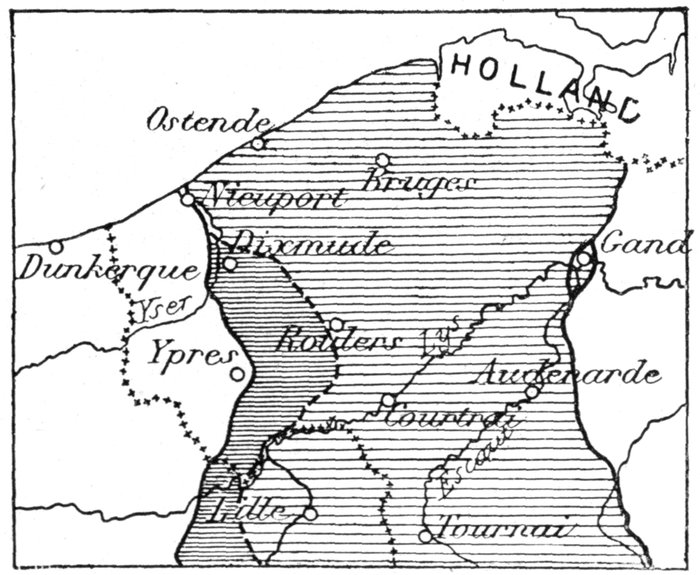
The Two Stages in the Flanders Offensive.
On October 17, the Belgian infantry reached Ostend, while their cavalry,
before the gates of Bruges, heard the belfry chimes joyfully announce the
precipitate departure of the last of the enemy troops. The Allies' advance
had been so rapid that the
Germans had not time to
set fire to the city. On
the coast, the port of Zeebrugge,
together with
huge quantities of stores,
fell into the hands of
the Belgians.
The whole of the maritime
Plain of Flanders
was thus liberated. The
exhausted, demoralised
enemy were in full retreat.
On November 11,
beyond Ghent, the Armistice
saved them from
the utter rout into which
their defeat was fast degenerating.
[Pg 23]

The Itinerary starts from Dunkirk and is divided into four days.
- First day:
- Dunkirk, Nieuport, Ostend (pp. 24-66.)
- Second day:
- Ostend, Zeebrugge, Bruges (pp. 67-85.)
- Third day:
- Bruges (pp. 86-111.)
- Fourth day:
- Bruges, Dixmude, Poperinghe (pp. 112-127.)
Poperinghe is the nearest touring centre to Ypres. For the itineraries
between Ypres and Lille, see the Michelin Guide: "Ypres, and the Battles
of Ypres".
[Pg 24]
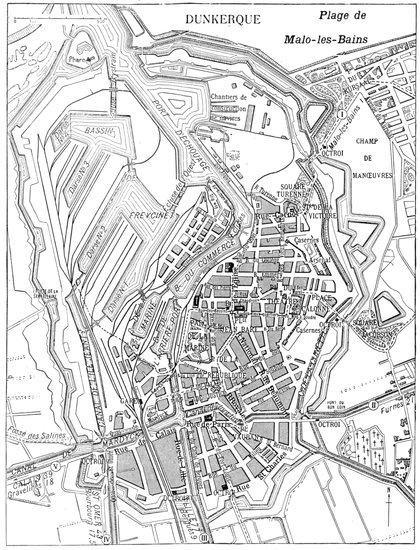
PLAN OF DUNKIRK.
- A. Church of St-Éloi.
- B. Belfry.
- D. Church of John-the-Baptist.
- E. Chapel of Notre-Dame des Dunes.
- F. Church of St-Martin.
- H. Hôtel-de-Ville.
- T. Theatre.
[Pg 25]
Origin and Chief Historical Events.
The first mention in history of Dunkirk goes back to the 10th century.
As early as the 12th century, it proved to be an "Apple of Discord" between
the kings of France and the counts of Flanders. Few towns have had such
a stirring history. Ten times besieged, it was taken by Condé in 1646.
Recaptured at a later period by the Spaniards, it was given back to the
French by Turenne, after the battle of the Dunes (1658). Louis XIV ceded
it to his ally Cromwell, but redeemed it from Charles II of England in 1662.
The Dunkirkian corsairs—most famous among whom was Jean-Bart (1651-1702)—inflicted
such losses on the English, that the Treaties of Utrecht and
Paris (1713 and 1763) provided for the destruction of the port. In 1793, the
town was besieged for the last time. By holding out for three weeks against
40,000 men under the Duke of York, it enabled General Houchard to reach
Hondschoote, where the English were decisively defeated. This feat of
arms was commemorated by the device: "Dunkirk deserved well of the
country, 1793", which was inscribed on the city's coat-of-arms.
During the Great War of 1914-1918, Dunkirk was an extremely important
revictualling centre for the Allied troops. It also played a great part in
helping to keep the mastery of the North Sea, and as such, was constantly
bombarded by the enemy. It was to reach Dunkirk and Calais, that the
Germans made their furious thrusts at Ypres and on the Yser. Of all the
towns not directly in the front-line, Dunkirk was probably the one which
suffered most. It was bombarded once by Zeppelins, seventy-seven times
by aeroplanes and four times by warships. Lastly, a 15in. naval gun posted
twenty-three miles away, shelled the town at regular intervals from April
1915 onwards. In all, more than eight thousand shells fell in the town,
killing five hundred people and wounding over one thousand others. In
spite of all, the town maintained considerable activity throughout the war.
The damaged and destroyed buildings were rapidly cleared away or repaired.
Under bombardment, the shipbuilding-yards turned out three vessels of[Pg 26]
19,000 tons. Munitions of war were also manufactured in very large quantities.
The following citation in the Army Order of October 17, 1917, which
is to be incorporated in the city's coat-of-arms, was well deserved:

Quai de la Citadelle struck by a 15in. shell.
Subjected for three years to violent and frequent bombardments, Dunkirk was
able, thanks to the admirable coolness and courage of her inhabitants, to maintain
and develop its economic life in the interests of National Defence, thereby
rendering invaluable service to the Army and Country. This heroic city is an
example to the whole nation.
The Croix de la Légion d'Honneur was conferred on Dunkirk by President
Poincaré on August 11, 1919.
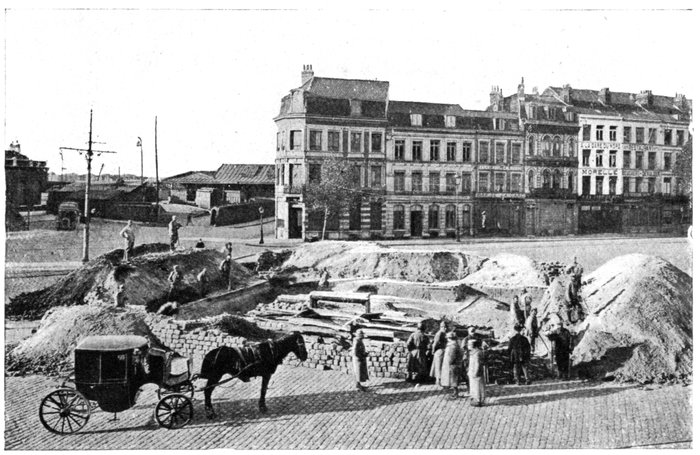
Building a bomb-proof shelter in front of the Station.
[Pg 27]

Protecting the mechanism of the Locks from the Shells.
A Visit to Dunkirk.
Follow the arrows along the streets indicated by thick lines in the plan below.
Starting-point: Place Jean-Bart in the middle of
which is a statue of Jean-Bart (1844) (photo below).
[Pg 28]
Take Rue de l'Eglise (Rue Clemenceau) in which, immediately to the right,
stands the Church of St. Éloi with the Belfry opposite.
Built in the 16th century, St. Éloi Church contains a nave flanked by
four side-aisles. The first bays, nearest the façade, having being pulled
down, the belfry—an old watch-tower, which formerly abutted on the
church—is now separated from it by the width of the street. The façade was
rebuilt in 1890. In the interior are a fine XVIIIth century pulpit, some old
paintings, and the tomb of Jean-Bart (left aisle) (photo, p. 29). The right
aisle was torn open by the shells (photo below).
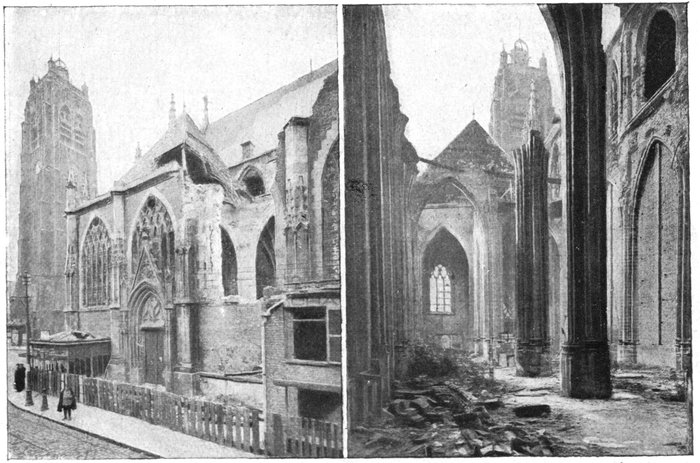
The Belfry, and ruined side aisle of St. Éloi Church.
Exterior. Interior.
[Pg 29]
The Belfry, a large square tower of brick,
190 feet high, was built in 1440. It contains
a peal of bells. From the top, there is a very
fine view.
The entrance is on the rear side of the tower.
Take Rue des Bassins, opposite the church,
and turn to the right along Rue de La Panne, in
which stands the Church of John-the-Baptist.

Church of John-the-Baptist.
This 18th
century
church
contains
some fine
paintings.
On the altar:
The Consecration of Dunkirk to
the Virgin (Elias); in the chancel,
The Death of Mary the Egyptian (G.
de Crayer); The Holy Family (Erasme
Quellin); The Holy Family (Le
Guide); Jesus crowned with thorns
(Van Dyck). In the nave: Paintings
by Elias and de Janssens. On the
northern side of the church are the
cloister and modern chapel of St. Philomène
(shrine).
Keep along Rue de la Panne; follow
Quai des Hollandais, and turn to the
right into Place d'Armes, in which
stands the Hôtel-de-Ville.

Quai des Hollandais and the Hôtel-de-Ville.
The Hôtel-de-Ville was rebuilt in
1896-1901 of brick and stone (architect,
L. Cordonnier). On the first
floor are statues of illustrious Dunkirkians.
Just below the roof
there is an equestrian statue of
Louis XIV. The tower is 250
feet high.
[Pg 30]
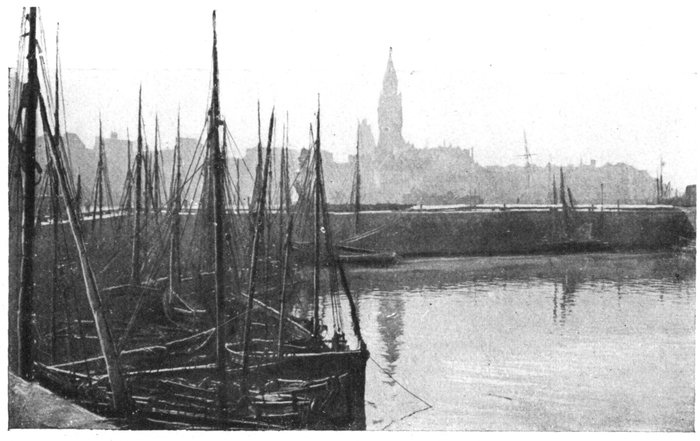
Fishing-boat Dock. In the background: Hôtel-de-Ville and Belfry.
Take Rue du Quai, on the left, to the large square in front of the port, in
which is the Fish-Market (Mynk). (See sketch-map, p. 27.)
The port of Dunkirk.
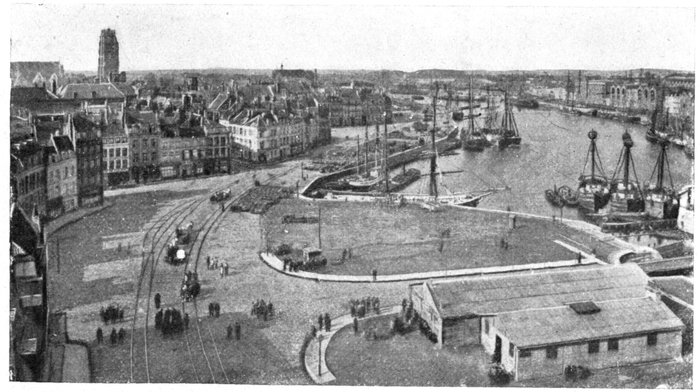
General View of Dunkirk and the Docks.
One of the busiest fishing and coast-trading ports in France, Dunkirk is
especially important by reason of its import trade. The raw materials
required for the industries of Northern France are discharged there, whilst
iron ore, oil and metals are exported. Since the beginning of the 19th century
Dunkirk has steadily grown and the fortifications have twice had to be
extended (1861-1906). The ruined industries of the North and the competition
of the Rhine may retard this growth, but the port's natural situation
will always ensure a fine future for it. In 1920, the docks covered an area of
about 100 acres, whilst the total length of the wharves was about six miles.
[Pg 31]
The port consists of a series of parallel docks, i.e., the extended rear port,
the naval dock, the commerce dock, and wet-docks 1, 2, 3, 4, connected
by the Freycinet dock. All these docks lie at right-angles to the great
water-line formed by the grounding port and outer harbour, into which the
channel debouches. Dunkirk also possesses extensive naval stocks provided
with five large dry docks and a launching dock fifteen acres in extent (See
plan, p. 24.)

The Outer Port of Dunkirk and the Channel.
To visit the port, cross the bridges over Citadelle Lock and Western Lock;
turn to the right along the quay, passing behind the wet-docks and skirting
the graving-docks. On the right, on the other side of the grounding port,
the naval dock-yards come into view. Cross the bridge of Trystram Lock,
which connects up Freycinet Dock with the channel, then turn immediately
to the right and cross the small bridge opposite the lighthouse, leaving the latter
on the left. Skirt the channel (about 230 yards long and 27 yards wide), as
far as the two booms which terminate it. There are several observation-posts
and armoured concrete machine-gun shelters near the lighthouse.
[Pg 32]
Return to the square in front of the port and
follow the quay, on the left, as far as Rue Carnot
on the right, which leads to the Chapel of Notre-Dame-des-Dunes.
(See itinerary, p. 27).
This chapel is a favourite pilgrimage. The
fisherwomen of Dunkirk made it the headquarters
of their Sisterhood.
A little further on stands the Statue of Victory
commemorating the siege of 1793. This monument
is the work of Ed. Lormier (1893) and was
erected on the site of the old ramparts.
Follow the tram-lines to Malo-les-Bains,
Dunkirk's beach.
Return to Rue Carnot and take Rue des Vieux-Remparts
on the left to Place du Theatre, where
turn to the left into Rue Benjamin-Morel, in
which stands The Museum (photo below.)
Take Rue Jean-Bart on the right, behind the theatre, then Rue Thévenet on
the left, leading back to Place Jean-Bart.
Cross the latter diagonally to Rue Alexandre
III (see Itinerary, p. 27) which leads
to Place de la République. Here stands
the monument erected to the memory of
the Dunkirkians who fell fighting for their
country. (L. Morice, 1906.)
Cross Place de la République, then
Place du Palais-de-Justice, turn to the
right along Quai du Port au Bois then cross
the bridge on the left (see Itinerary, p. 27).
Take Rue de Paris on the left, in which
stands St. Martin's Church. This modern
church, primitive Gothic in style, is
flanked by two towers with spires.

Church of St. Martin and Rue de Paris.
The tourist leaves Dunkirk by Rue de Paris and Rue des 4-Ecluses, which
prolongs it, to follow the itinerary of the first day.
[Pg 33]
A VISIT TO THE YSER BATTLEFIELD
AND THE BELGIAN COAST.
First Day:
DUNKIRK, NIEUPORT
AND OSTEND.
Lunch at Nieuport.
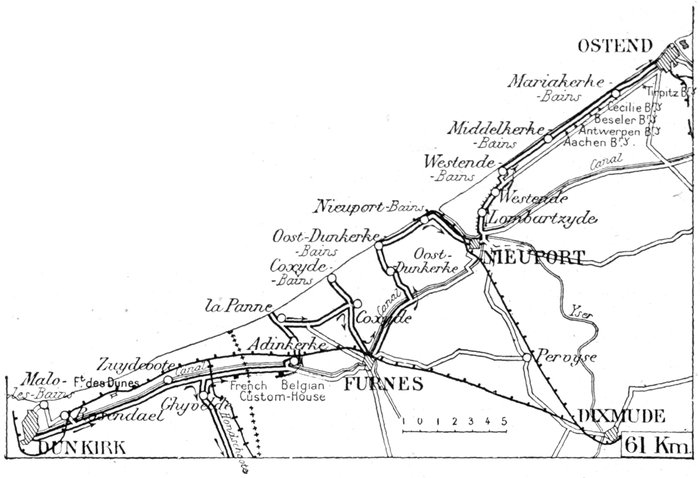
Leave Dunkirk by Rue de Paris, continued by Rue des 4-Ecluses, cross
the Canal de la Cunette (see lower half of itinerary, p. 27, and text, p. 32), and
take the Furnes road (D. 15) which follows the right bank of the Dunkirk-Furnes
Canal.
At Rosendael (2½ kms. on the other side of the canal) stood the Civilian
Hospital of Dunkirk, which was shelled several times during the war.
On the left, 3 kms. further on, is Dunes Fort.

Hospital at Rosendael bombed by a German aeroplane.
The baby in the medallion had one of its hands cut off by a splinter.
[Pg 34]

Sanatorium at Zuydcoote. (Cliché LL.)
At the first cross-roads (9 kms. from Dunkirk), the tourist may take the left-hand
road to Zuydcoote, to see the great Sanatorium for children, on the
coast, founded by M. Van Covenberghe. Converted into a military hospital,
it rendered invaluable service during the War (photo above).
To visit, go through Zuydcoote, turn to the left, beyond the level-crossing,
then to the right 200 yards further on.
Return to D. 15, and follow same on the left.
At the first cross-roads (2 kms.) take G. C. 4
on the right to Hondschoote (12 kms.)
Pass through Ghyvelde, then at Les
Moeres turn to the right, and on leaving,
to the left.
Beyond the level-crossing, Hondschoote is
reached. Take Rue de la Prévôlé on the left, which leads
to the Grand' Place.
Hondschoote is a small town of ancient origin,
whose population has greatly decreased since the
16th century. It was there that, on September
8, 1793 the French, under Houchard, defeated and
drove back the English who were besieging Dunkirk
(engraving below).
On the right of the Square (photos, p. 35) is the 17th
century Renaissance Hôtel-de-Ville, while in the centre
stands the early 16th century church, in which are
a fine pulpit and organ loft (1755). Near by is a monument (Darcq) commemorating
the victory of 1793.

The Victory at Hondschoote. (21 Fructidor, Year 1.)
[Pg 35]

Hondschoote.
Hondschoote Church.
In front: 9in. Mortars.
In the medallion:
The Pulpit.
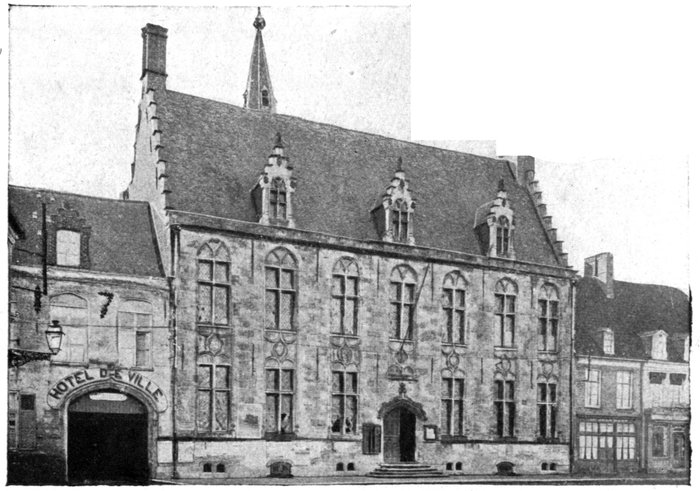
Hondschoote. The Hôtel-de-Ville.
[Pg 36]

Verhaeren's Tomb at
Adinkerke (1918).
Return to D. 15 and follow same to the
right; cross the railway (l.c.); 2 kms. further
on is the French Custom-House. The
Belgian Custom-House
is 3 kms.
further on, near
Adinkerque.
Cross the canal
and enter
Adinkerke.
Take the street
on the left which
skirts the churchyard.
Behind
the church is
a large Franco-Belgian
cemetery, containing the
grave of the Belgian poet Verhaeren.
After the Armistice, his remains were
transferred to his native town.
Keep straight on along the La Panne road;
600 yards beyond the Dunkirk-Furnes
railway, a small foot-path on the right leads
to a military cemetery. La Panne is
next reached (3 kms.). This small seaside
resort was one of the least modern places on the coast. Follow Avenue
de la Mer as far as the dike, to the left of which are three villas which were
occupied during the war by King Albert and his staff.

Reception of President Poincaré by King Albert at the Royal Villa,
La Panne, January 22, 1917.
[Pg 37]

Villa of the French
Mission at La Panne
(October 1916.)
Return along Avenue de la Mer to the first street
on the left, in which is the Hôpital de l'Océan.
0 km. 800 further on, on the left, take the street
which runs alongside the local railway. At the
first fork, take the left-hand road to Coxyde (5 kms.
from La Panne.) Wire entanglements and shelters
in the Dunes may be seen all along the road.
There is a military cemetery on the left, O km. 500
before reaching Coxyde.
Coxyde, like most of the towns on the coast,
is divided into the town proper, situated behind
the Dunes, and the Baths on the coast.

Concrete Gun Shelter,
100 yards east of Coxyde-Bains.
Turn to the left on entering the village. The road
crosses the Dunes, which are highest at Hoogen-Blekker
(105 feet). Vestiges of trenches, wire
entanglements, shelters and gun emplacements
are to be seen on every hand.
In the Dunes, on the right, is
an emplacement for naval guns
(Photo opposite). Between this
position and the sea is the camp
known as that of Adjutant Lefèvre
(Photo below).
The tourist may go as far as
Coxyde-Bains (2 kms.) Return
to and cross through Coxyde, keeping
straight on to Furnes (3½
kms.)

The Camp of Adjutant Lefèvre at Coxyde-Bains.
[Pg 38]

Hôtel-de-Ville, Palais-de-Justice, Belfry, Church of St-Walburge.
The Grand'Place, Furnes.
FURNES
Furnes (Veurne) is a small town of about 6,000 inhabitants. Of ancient
origin, it was the chief town of the "Veurne Ambacht" castellany, in the
Middle-Ages. By the Treaty of 1715, the Dutch were empowered to place
a garrison there, as a barrier against France.
During the War, Furnes became, after Antwerp and Ostend, the General
Head-Quarters of the Belgian Army for a few months (1914-1915),
the same being subsequently transferred to La Panne. More fortunate
than Dixmude and Nieuport, practically all its public buildings and monuments
escaped uninjured, although parts of the town were seriously damaged
by the bombardments.
On January 28, 1920, President Poincaré, in the presence of King Albert,
fastened the French Croix de Guerre to the town's arms, with the following
citation:
"During four trying years, in spite of incessant bombardments by aeroplanes
and long-range guns, always set a fine example of unshakeable faith in the
final Victory".
Tourists arrive by Rue du Nord which opens out into the Grand' Place,
the ancient ornamental paving of which is very fine. Around the square
are grouped the principal buildings.
The Hôtel-de-Ville is on the right.
Renaissance in style, it was erected
in 1596-1612, from the plans of Lieven
Lukas. The façade has two gables,
one of which was preceded by a graceful
loggia which was removed during
the war (Photo, p. 40). The high
belfry dates from 1628. On the ground-floor
see: the Council Chamber, with
Spanish leather hangings: the College
Chamber, with Utrecht velvet hangings;
the Marriage Hall, with a [Pg 39]still-life
painting attributed to Snyders (on the mantelpiece). The Great Hall on
the first floor, with Spanish leather hangings, contains several royal portraits.
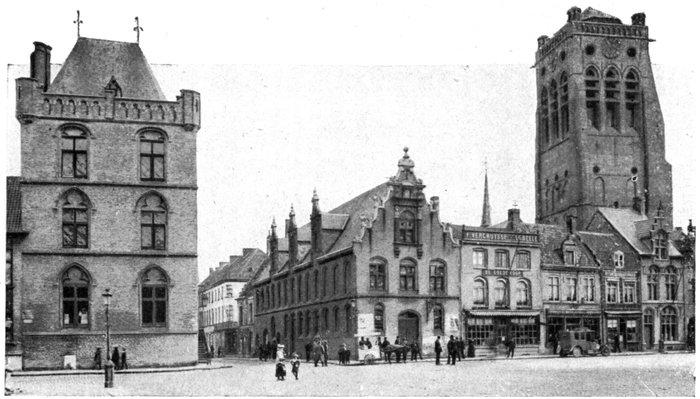
Spanish Officers' Pavilion. Rue de l'Est. Meat Market. St-Nicolas' Tower.
The Grand'Place, Furnes.
Near by is the Palais-de-Justice, formerly the ancient castellany,
built in 1612-1628 from the plans of Sylvain Boulin. Behind the Palais-de-Justice
is the Belfry. The interior, restored in 1894, comprises several
finely decorated rooms: the Waiting-Hall, the Justice Chamber (17th
century), and the old Inquisition Chamber (on the first floor). The Chapel
contains some fine vaulting and a carved wooden gallery. A number of
bronze tablets recording judgments are kept there.
A narrow street between the Palais-de-Justice and a block of old houses
with ruined gables, of which only mutilated fragments of the façades remain,
leads to the Church of St. Walburge.
Of very ancient origin, its reconstruction was begun in the 14th century.
The choir was completed in the 15th century. The nave is 14th century.
The church contains magnificent stalls (early 17th century), wood-work,
doors, and pulpit, also a Descent from the Cross attributed to Pourbus. In
the sacristy there is a 15th century shrine. The stalls, organ and altars
were removed to a place of safety during the war. Much of the stained-glass
was destroyed.

St. Nicolas' Tower. Spanish Guard House.
The Grand'Place, Furnes.

Furnes. The loggia of the Hôtel-de-Ville.
(Sept. 4, 1917.)
At the corner of the Grand' Place and the Rue de l'Est stands
the Pavilion of the Spanish Officers, built by the Spaniards
in the 16th century as a barracks. Restored at[Pg 40]
a later date, it now
serves as the Town
Library and Archives
(Photos, pp. 39
and 41).
Opposite is the old
Meat Market, now
a theatre, with its
fine early 17th century
façade.

Furnes. The Palais-de-Justice (Ancient Castellany).
On the left, the Hôtel-de-Ville whose "loggia" (photo above) was taken down (1918).
At the end of the
square, facing the Rue
du Nord, is the
Old Spanish Guard
House, an arcaded
building of early 17th
century construction.
The lateral façade
overlooks the
Place du Marché-aux-Pommes,
in
which stands St.
Nicolas' Church.
Begun in the 14th
century, building was
continued in the
15th, and completed
in the 16th centuries.
The church,[Pg 41]
which has a high, unfinished tower suffered little during the war, although
some of the stained-glass was broken.
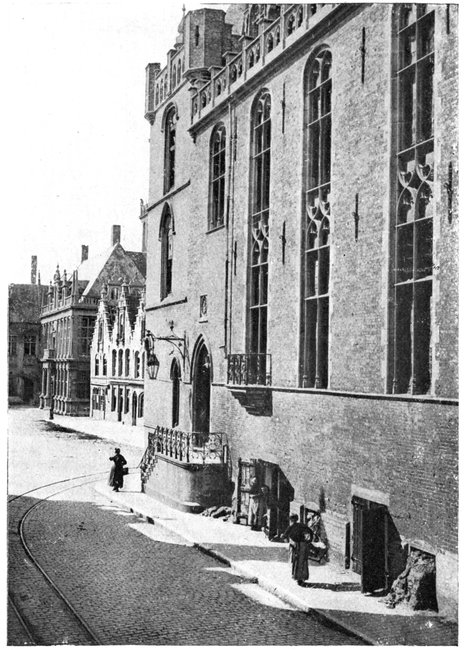
The door of the Spanish Officers' Pavilion (Sept. 4, 1917).
In the background: The Palais-de-Justice and Hôtel-de-Ville (photos, p. 40.)
In the foreground: Rue de l'Est, by which tourists leave Furnes.
Furnes possesses a number of curious old houses, the most noteworthy
of which are the Noble Rose Hostelry, 11, Rue du Nord, near the Grand'Place,
and the Pomme d'Or Hostelry in the Grand'Place.
Victor Hugo lived in one of them in August 1837. The "Pomme d'Or"
was used as a residence by the Spanish Officers (16th-17th centuries).
Rebuilt in the 16th century, the "Noble Rose" was restored shortly before
the War; it is now partly destroyed.
Every year, since the 12th century, a famous penitential procession took
place at Furnes on the last Sunday in July, when the "Sodalité Brotherhood"
performed the "Passion Play" in Flemish.
[Pg 42]
From Furnes to Nieuport.
Leave Furnes by the Rue
de l'Est, and immediately
after crossing the canal,
take the Nieuport road, on
the left. At Wulpen (5
kms.), cross the canal to
go to Oost-Dunkirk (2
kms.) Numerous shelters,
trenches, and wire entanglements
are to be
seen along the road.
After crossing the railway
(l.c.) turn to the left
into Oost-Dunkirk. Like
Coxyde, Oost-Dunkirk
comprises the town proper—situated
behind the dunes, on a road which, via Coxyde, linked up
Furnes with Nieuport—and the baths, 2 kms. further north, on the coast.
Both places served as billeting quarters for the French Marines in 1915.
The immense camps of wooden huts were occupied
later by the Zouaves.
The town was practically destroyed by the
bombardments; most of the houses are in ruins,
but the church is still standing.
To visit the Baths (2 kms.) take the road on the
right, beyond the church, noticing the numerous
shelters in the dunes. Coming back from the dike,
take the first road on the left to Nieuport-Bains
(4 kms.) The road crosses a region covered with
defence-works, trenches and wire entanglements,
alternating with shelters and battery positions.
The battle zone began there. All vestiges of life
and vegetation have disappeared.
Before reaching Nieuport-Bains, a Franco-British
cemetery [Pg 43](photo below) is seen on the left, and
a little further on, the ruins of the church, with a cemetery in front.
Nieuport-Bains, a small watering-place situated 3 kms. from Nieuport
and 17 kms. from Ostend, was perhaps the prettiest of the Belgian seaside
places. There the dunes rise in places to a height of 100 feet.

Cemetery at the entrance to Nieuport-Bains.
As witness the trenches
and boyaux which run
through the ruins of its
pretty villas and fine hotels,
Nieuport-Bains stood
in the front line.
At the end of the dike
the road turns to the right
in the direction of Nieuport-Ville.
From here the
tourist crosses the dunes
parallelly to the sea.
Traversing the zone which
formed the first line during
the stabilisation
period, the mouth of the
Yser, protected by two wooden piers about three-quarters of a mile long
and covered with sacks of earth, is reached. The Grande Dune, which
General de Mitry attacked in January 1915, is on the right bank of the
estuary, opposite Nieuport-Bains. The polders of Lombartzyde are somewhat
to the south-west (See p. 53).

The Hotels on the sea-front at Nieuport-Bains.
Broken fragments of walls mark the site of the station on the dune. In
front are a derelict engine and train, which have been there since 1914.
Near by is the entrance to the covered trench which connected Nieuport-Ville
with Nieuport-Bains; same may be visited.
Return to the car and take the road to the left towards Nieuport-Ville (photo
below).
Proceed to Nieuport (3 kms.) by the road (very rough) running parallel to
the estuary of the Yser, past several shelters and artillery positions. After
crossing the bridge over a small canal, the tourist comes out on the wharves of
Nieuport. Once an important fishing port, little remains today of its
former prosperity. A few fishing boats still give some little activity to the
place.

Road leading to the mouth of the Yser.
At the end of the dike, leave the car and go on foot, in the direction of arrow A,
along the path leading to the mouth of the river (photos, p. 44). Return to the car
and take the road to the left (arrow B.) to Nieuport-Ville.
[Pg 44]

Wooden Pier at the
mouth of the Yser.

On the right:
View, looking towards
the sea.

On the left:
View looking towards
Nieuport.
In the foreground: Concrete
Shelter and destroyed
Wooden Pier.

Below:
French Trench along the Beach,
to the left of the river mouth. In
the background: Nieuport Pier.
[Pg 45]
The small town of Nieuport is of very ancient origin. As early as the
9th century its site was occupied by a castle built by the Counts of Flanders
to defend the coast against the Normans. The burgh, first known as Santhoven,
took the name of Nieuport (Neoportus) after the inhabitants of Lombaertzyde
had migrated there. Situated on the Yser, the town served as
a port for Ypres, and was an important business centre. It was besieged
by the English in 1383 and by the French in 1489.
After a long period of stagnation, the enclosing walls were pulled down
in 1860. However, with laudable respect for the past, the Municipality
saw to it that the charming old-world aspect of the place was carefully
preserved, by severely controlling the plans of all new constructions, and
by prohibiting the use of materials not in harmony with the buildings
already existent.
Nieuport, of which nothing remains but a few scattered ruins, was the
scene of desperate fighting.
With Dixmude, it was one of the two main centres in the Yser defences,
these two towns being, in fact, the bastions of the line of resistance.
Amongst other things, Nieuport possessed an elaborate system of lock-gates
and sluices, by means of which the water in the canals throughout
maritime Flanders was regulated.
It was easier to defend than Dixmude. The canals and water-courses
which united in its port, separated the town from the enemy. It
could, moreover, be more effectively protected by the guns of the Allied Fleet.
In October 1914, the Belgian 2nd Division held the outlying defences at
Lombartzyde and Mannekensvere (east of St. Georges).
On October 19, it was attacked by the German 4th Reserve Division.
Three consecutive attacks against Lombartzyde having failed, the enemy
began to shell Nieuport with their heavy artillery.
Renewing their attacks, the enemy captured Lombartzyde, but were
unable to debouch. Crushed by the bombardment, Nieuport fell into
ruins.
From October 18 to 25, in spite of the heavy bombardment, the Belgian
7th Infantry Regiment held the banks of the Yser, to the east, in front of
St. Georges, near the Union Bridge, which the Germans, debouching from
Mannekensvere, tried in vain to carry. The Belgian batteries, often without[Pg 46]
cover, stubbornly supported the defenders. On several occasions, guns
were hauled up on the river bank into the infantry lines, whence their direct
hits smashed the farmhouses and German machine-guns concealed in them.

Panorama of the ruins of Nieuport, seen from King Albert's Hôtel.
The enemy crossed the Yser at Schoorbakke, outflanking St. Georges
from the south, which had to be evacuated.
Instantly, batteries of the Belgian 5th Brigade, brought up by hand,
opened a rapid fire at short range with high explosive shells upon St. Georges
and the approaches to the canal, where the enemy were concentrating.
Mowed down where they stood, the assailants vainly attempted
to debouch from the village, where piles of their dead lay among the ruins.[Pg 47]
The 14th Line Regiment, which had meanwhile relieved the 7th, was able
to withdraw in good order.
At nightfall, the batteries were gradually withdrawn behind the railway
whence they helped first to hold, then to force back the German attack
upon Ramscappelle.
The defenders being now exhausted, and the enemy's attack gathering
strength, the Belgian General Staff gave orders to flood the area between the
Yser and the railway embankment. The road to Calais, via Nieuport, was
thus definitely barred to the invaders.
The Germans revenged themselves by bombarding Nieuport, attempting
at the same time to slip along the dunes of Lombartzyde, towards the town,
in order to seize the locks. Before the unflinching resistance of the defenders
supported by the fire of the British and French monitors, the attack broke
down.

Temporary Foot-bridge across the Yser at Nieuport.
[Pg 48]

Nieuport, the Grand'Place and the Markets, before the War.
(Photo Nels.)
At the beginning of November Lombartzyde, in the northern sector, was
the scene of uninterrupted fighting, with alternating advances and retreats.
In December a powerful offensive, having for its objective the capture of
the German defences along the Belgian sea-coast, was begun, with General
de Mitry in command of the Nieuport forces.

Ruins of the Grand'Place in 1919. (See photo above.)
On December 16, the French carried the western outskirts of Lombartzyde
in a single rush, and reached the first houses of St. Georges. The
enemy, however, resisted desperately, and progress was slow. By the end[Pg 49]
of the month, the Moroccan Brigade succeeded, with great difficulty, in
reaching the Grande Dune. On January 7, the 4th Regiment of Zouaves
scaled the Mamelon Vert. A few days later the French Marines, who
had been relieved in the Steenstraate sector, by Tirailleurs and dismounted
cavalry units of the 2nd Corps, attacked the Grande Dune and Lombartzyde.
After extremely desperate fighting, entailing heavy losses, the Grande Dune
was captured.

Nieuport.
The ruined
church.
The attack was stayed, and the French clung to the thin strip of land on the
right bank of the Yser.
The bombardment of Nieuport increased in violence. Each morning, the
huge 16½in. shells wrecked the houses and public buildings, and crushed in
the cellars where the defenders had taken shelter. One after another, the
12th century Church, the Abbey on the Dunes, the "Halles" with their
graceful belfry, and the massive Templars' Tower crashed to the ground.
Meanwhile, the battle continued to rage all around the town.
On May 9, a German attack from Lombartzyde to St. Georges was
broken, and on the following day the French marines carried "W" and
Union Farms, with fine dash, and destroyed the enemy's blockhouses.

Nieuport.
Ruins of the
Hôtel-de-Ville.
[Pg 50]
In 1916 (January 24), after a bombardment of more than 20,000 shells,
the Germans attempted to debouch from their positions near the mouth of
the Yser. Repulsed with heavy loss, they once more deluged the unhappy
town with shells.
In 1917, the British prepared their great Spring and Summer offensives,
extending from east of Arras to the region of Ypres, and relieved their French
comrades in the sector stretching from St. Georges to the sea.
They had hardly taken up their positions, when the Germans attacked
(July 10). Thrown back into their trenches before Lombartzyde, the
enemy renewed their attacks with increased violence, and forced back the
British in the direction of Nieuport. The latter managed, however, to keep
a bridgehead at the exit from the town.
Meanwhile, in the Dunes sector, two British Battalions, in spite of their
gallant resistance, were forced back upon the river. Of these, only four
officers and seventy men escaped, by swimming across during the night.
The Germans on the right bank of the river occupied the Dunes.
The pressure on Nieuport increased, but the Yser remained impassable.
In 1918 (September 28), the great liberating offensive, under the command
of King Albert, was launched in the plains, to the east of Dixmude, and
Ypres. On October 16, the Belgian 5th Division, east of Nieuport, charged
from the famous islets in front of the Yser. The enemy, badly shaken,
retreated, closely followed by the Belgians, who harried their rear-guards
and completely swept the coast to a point beyond Ostend.
Nieuport, terribly ravaged by four years of the fiercest fighting at its very
gates, was at last delivered.
On January 25, 1920, in the presence of King Albert and the Burgomaster,
President Poincaré conferred the Croix de Guerre with the following mention
on the indomitable city:
"Martyred City, involved in all the vicissitudes
of a desperate struggle lasting four years,
Nieuport maintained intact her faith in the
future, in spite of all her trials.
Her ruins bear witness to the heroism of
her defenders and to the bravery of her inhabitants."

Nieuport.
Furnes Canal
Lock (Nov. 11, 1915)
Inset: Lock-Keeper
Geraert, who flooded
the Plain
(See p. 51.)
[Pg 51]
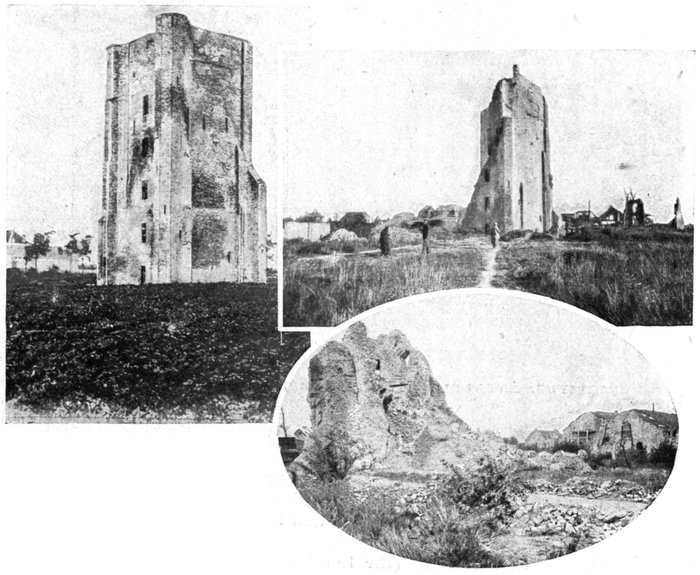
The Templars' Tower.
Before the War, in November
1915, and in 1919.
On reaching the wharves, take the first street on the right, then the second on
the left, to the Grand'Place, in which the Collegiate Church of Notre-Dame
used to stand.
Consecrated in 1163, this Gothic edifice had retained portions of the original
12th century church. The northern doorway was 15th century, and
the main entrance 16th century. The tower was somewhat massive. In
the interior, a 15th century rood-loft, the high altar (1630), the 17th century
stalls (by Desmet), a 15th century pulpit, an ancient tabernacle (by Jean
Aert of Bruges-1733), and several old tombs, were noteworthy.
Nothing remains of the church but broken fragments of walls and the
ruined belfry. In the surrounding graveyard, among the broken tombstones,
Belgian and French soldiers lie buried. Their graves were often
devastated by the shells.
In the same square stood the 14th-15th century Cloth-Hall, whose belfry
was restored in recent times. Only a portion of the façade remains.
At the end of the Square, opposite the Markets, take Rue du Marché, then
the first street on the right (Rue Longue). At the corner of these two streets is
the Hôtel-de-Ville (in ruins) which used to contain portraits of the kings
of Spain and the arch-dukes.
Continue to the end of Rue Longue, where, on the right, are the ruins of
the Templars' Tower. The square donjon is all that remains of a commandery
which formerly belonged to the Templars, and which was destroyed
during the siege of 1383. Behind, are vestiges of the ancient city
ramparts.
Return to the port by the first (very wide) street on the right, which leads to
the Ostend Road Bridge across the Yser. To the right of the bridge are the
Nieuport locks which served, during the War, to inundate the surrounding
country, being opened at high water and closed at low water (see photo, p. 50).
[Pg 52]

Lombartzyde. Avenue de la Reine, before the War (Photo Nels.)
From Nieuport to Ostend.
1½ kms. further on, the tourist reaches the site on which Lombartzyde used
to stand (2 kms.); the scarcely visible ruins are now overrun with grass
and weeds. A few huts and a wooden church have recently
been built.
Lombartzyde (the Lombards' Corner) owed its name and
prosperity to the merchants and bankers, many of them
Lombards, who settled there in the Middle-Ages. The town
was, however, soon deserted in favour of Nieuport. Its
large plain church, of no particular interest, contained a
statue of the Virgin, much venerated by the fisher-people, who
often visited it in the summer-time. Lombartzyde, formerly
a sea-port, was later cut off from the sea by the Dunes,
and Lombartzyde-Bains—the seaside portion of the town—grew
up there. The steam-trams running between Nieuport and Ostend
may be taken to reach it.

Lombartzyde. Avenue de la Reine, in 1919. (See photo above.)
[Pg 53]

Lombartzyde. Graves and trenches on the site of the Church
(entirely razed).
Situated about 1 km. in front of Nieuport, on the right bank, Lombartzyde
was occupied on September 15, 1914, by the advanced posts of the
Belgian 2nd Division.
In danger of being turned, it had to be abandoned on the 20th, at about
3 p.m., together with Groote-Bamburg Farm, likewise situated in front of
Nieuport.
For a short time the town was reoccupied by the French, but finally
remained in German hands. Neither the attack on the Grande-Dune in
December 1914, nor the Belgian advance to the outskirts of the town a little
later, could drive the enemy out.
Groote-Bamburg Farm, formerly belonging to the lay monks, lies to the
east of Lombartzyde; there is no carriage road, but a foot-path, starting
opposite the church, leads there in 20 minutes. Of the farm, nothing remains
but a maze of trenches, wire entanglements and concrete shelters.
Opposite the church, the old Avenue de la Reine (photos, p. 52) leads to the
Dunes, the importance of whose defences will become apparent (photo below).

Lombartzyde. The Mamelon Vert.
[Pg 54]

Road to
Westende
Bains.
ARROW NO. 1:
Turning
to the left,
tourists
leave the
main road
from
Westende
to Ostend
(See sketch
below.)

ARROW
NO. 2:
Turn to the
right,
towards the
ruins of a
large hotel.
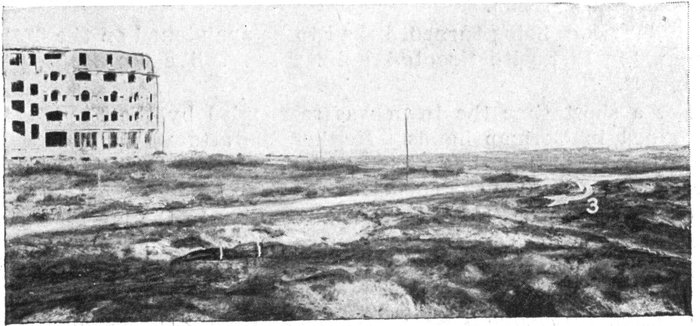
ARROW
NO. 3:
Take the
road to the
left, passing
near this
hotel.
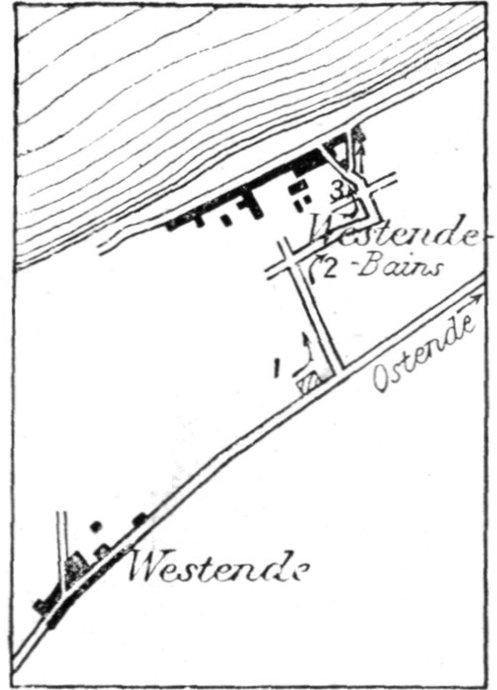
Road from Westende to
Westende-Bains. The
arrows correspond with
those on the photos above.
Keep along the road to Westende (1½ kms.),
a small village situated on the road from Nieuport
to Ostend; steam-trams run between the
latter towns.
The village was entirely razed, and the site
cut up with trenches.
Westende-Bains is 1 km. further along the
coast.
The Germans installed themselves in both
places, which accordingly became targets for
the British monitors.
Beyond Westende-Village, take the rough road
on the left (photo above). Before reaching the
ruins of Westende-Bains (2 kms.) (photo above),
turn to the right, then take the left-hand road
leading to the sea dike (photo above), which
follow on the right, in the direction of Ostend.
Before setting out for Ostend, visit the ruins of
Westende-Bains, intersected with trenches.
[Pg 55]

Westende-Bains. Machine-Gun Post and Electrified Barbed Wire.
The cellars of the houses were consolidated, and turned into shelters
and battery positions.
All along the dike, and along the whole coast runs a line of barbed-wire,
through which the Germans caused a high-tension electric current to pass
(photo above).
Follow the dike, bordered on
the right with trenches, numerous
observation-posts and concrete
machine-gun shelters.

Westende-Bains.
The
sea-front.
Among the
ruins of the
houses:
88 m/m guns
in shelters.
[Pg 56]

Middelkerke-Bains.
The Promenade
along the dike.
On the left, in the
foreground: The
Entrance to the
Kursaal.
Below: The
Kursaal, used by
the Germans
as an
observation-post.
Middelkerke-Bains (3 kms.),
formerly a small seaside resort,
is next reached.
All the hotels
and villas are
in ruins, their
fronts having
been either ripped
open by
shells or blackened by fires. The Germans organised powerful defence-works
there, in view of Allied air raids and the possible landing of troops. Observation
and signalling posts, as well as shelters for machine-guns and
searchlights are to be seen all along the dike.
The Kursaal, an isolated building standing in front of the village, was
turned into a blockhouse, facing seawards; same includes two superimposed
observation-posts, a signalling post, and machine-gun shelters.
Continue along the dike, noticing the observation-posts, machine-gun and
small calibre artillery emplacements, as far as the "Aachen" Battery on
the right.
This is the first of the formidable coast-defence batteries organised by
the Germans. The itinerary takes the tourist to most of these batteries,
all of which were fitted with heavy guns.
They were served by standard or narrow-gauge tracks, some having as
many as three tracks of different gauges.
At the time of the Armistice
the Germans blew up a large number
of the shelters, before leaving,
and destroyed most of the guns
which they had been unable to
evacuate.
They also removed all apparatus
from the observation and telemetric
posts.

Blockhouse of the Aachen Battery
(north-east of Middelkerke-Bains.)
An enormous blockhouse, situated
on the left of the "Aachen"
Battery, contained an observation-post
and the post-of-commandment
of the officer in charge
of the firing. Near by, are the
four 6in. armour-protected guns[Pg 57]
on concrete platforms, with concrete personnel and ammunition shelters
on either side. In front of the battery, near the beach, were anti-aircraft
machine-gun posts.
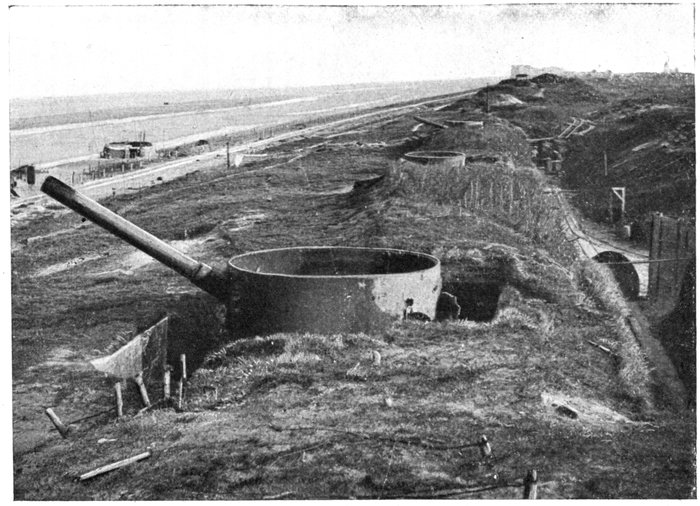
General View of the Aachen Battery (north-east of Middelkerke-Bains.)
The "Aachen" Battery was connected by infantry defence-works to the
next or "Antwerpen" Battery, situated on top of the dune. The latter
comprised four 4in. guns in armoured turrets, with sand-covered concrete
shelters behind. In front, on the dike, are machine-gun emplacements.
The "Beseler" Battery, next reached, comprises four 6in. guns on concrete
platforms, with circular armour-plate protection. On each side two elevated
emplacements served as telemetric and observation-posts.
Further on is a large infantry entrenchment, with a shelter on the dike
for the searchlight, and an emplacement on either side for machine-guns
or small calibre artillery.

One
of
the
Beseler
Battery's
guns.
[Pg 58]

One
of
the
Cecilia
Battery's
guns.

The Cecilia Battery, photographed from an aeroplane at 13,000 feet,
in July, 1916.
Next comes the "Cecilia" Battery, similar to the "Beseler" Battery,
except that the guns are longer, and the armour-plate protection rectangular.
Having passed a series of observation-posts, including that of the "Tirpitz"
Battery, with its telemetric installation and machine-gun shelters,
the tourist enters Mariakerke-Bains (6 kms.), a small seaside resort in the
suburbs of Ostend.
Follow the tram-lines
along Avenue Léopold, separated
from the dike by a
row of houses, to Ostend
(2½ kms.) coming out
opposite the entrance to the
old Wellington Fort.

Observation-Post and
Telemetric Station
of the Tirpitz
Battery, near
Mariakerke-Bains.
(See pages 63-64.)
[Pg 59]
OSTEND.
In the 9th century, Ostend, then a hamlet, was situated at the eastern
end (Oostende) of a sand-bar belonging to the powerful St. Bertin Abbey
of St. Omer. Incursions by the Normans and the ravages of the sea had
almost entirely annihilated it when, in the 9th century, Robert le Frison
built a chapel to Our Lady there, around which a new village grew up.
Thanks to the herring fisheries on the Flemish coast—a flourishing industry
in the Middle-Ages, but since abandoned—Ostend grew and prospered.
The construction of defence-works at the end of the 16th century, by Guillaume-le-Taciturne,
conferred on the town the dangerous honour of becoming
the last rampart of the Utrecht Confederation against the Spaniards
of the southern provinces, and resulted in one of the longest and bloodiest
sieges (1601-1603) recorded in history. This three years' struggle cost one
hundred thousand lives and reduced the town to ruins.
Later, Ostend sustained further destructive sieges, e.g. by the English,
under Marlborough, in 1706; by the French under Marshal Lowendhal
in 1745. Meanwhile, and in the latter part of the 18th century, various
factors helped to restore the town's former prosperity, i.e. the "Peace
of Utrecht" (1713) which closed the Escaut, thus paralysing Antwerp
in favour of Ostend; and the wealthy "Indian Company" founded there,
but broken up ten years later for political reasons. The "Treaty of Aix-la-Chapelle"
(1748) having ceded the town to Austria, Joseph II caused
the maritime installations to be completed, and made it a free port, into
which the belligerent ships put during the American War. This revived
prosperity was again annihilated by revolution and the Napoleonic wars.
In the 19th century, Ostend discovered a new and fruitful source of wealth
in sea-bathing, and eventually developed into one of Europe's premier
seaside resorts.
Under the impulsion of Leopold II, who frequently resided there, extensive
works were carried out in the town and port at the beginning of the present
century. The channel was widened, the jetties rebuilt, the port enlarged.
A monumental bridge, the present maritime station, and the church of
St. Peter and Paul were built. The dike was prolonged westwards and
bordered with luxurious buildings. Parks and public gardens were laid
out. To the east, the Lighthouse Quarter was transformed, and the Royal
Road in the Dunes to Blankenberghe was made.
When, in August 1914, the Germans invaded Belgium, this "queen of
watering-places" offered a strangely moving sight until the middle of
October. British troops disembarked from the transports, marched in long
files through the streets, and encamped in the surroundings. Refugees
from all parts were temporarily housed in the bathing cabins. "Zeppelins"
and "Taubes" completed the terror and panic caused by the approach
of the invaders. The trains were crammed, and the maritime station
crowded with thousands of people seeking to get across to Britain. The
retirement of the Belgian Army along the littoral, after the fall of Antwerp,
marked the end of the season of 1914.
On October 14, the Germans occupied the town, from which the visitors
and part of the inhabitants had fled. Naval defences were organised,
the dike and dunes armed, while the palaces and villas along the dike, the
Kursaal, and other public buildings were occupied by the military staffs. The
town suffered severely from this occupation. British shells and aeroplane
bombs unavoidably increased the damage. The maritime station, and a
number of hotels and private residences in the central and eastern districts
were partly destroyed, while the glazed roof of the Banqueting Hall of the
Kursaal collapsed.
[Pg 60]
Many public buildings were transformed into Hospitals, dressing-stations,
and even stables. The furniture of the fine villas along the sea-front was
either sent to Germany or burnt as firewood. The wine-cellars were emptied.
Defilements, in accordance with Kultur's best practice, went hand-in-hand
with the destructions. Reconstruction and cleansing will require much time
and work. Yet, true to her past, Ostend will rise again, more beautiful
than ever, from her ruins.

Itinerary for visiting Ostend (indicated by the thick lines): The
Chalet Royal, Kursaal, Leopold Park, Chaussée de Thourout,
Tirpitz Battery, Rue de Leffingue, Docks, Church of St.
Peter and Paul, Outer Harbour, Wooden Pier, Hôtel-de-Ville,
Marie-Henriette Park (on leaving), Napoleon Fort.
[Pg 61]

Ostend Sands.
Gneisenau Battery, in front of the Royal Palace Hôtel.
A VISIT TO OSTEND.
On entering the town, skirt the Wellington Hippodrome, in front of which
portions of the old Wellington Fort may still be seen at the end of the Western
Dike. In front of the terrace of the Royal Palace Hôtel, on the dike, is the
"Gneisenau" Battery armed with 4in. guns (photo above).
Take Avenue des Courses to the Chalet Royal. Go round the latter by
Rue Courbe.
Between Avenue des Courses and Rue Courbe opens out, on the right, the
fine Avenue de la Reine, which connects the dike with the Grand Parc
Marie-Henriette (see p. 67).

The Sands and Chalet Royal, before the war (Photo Nels.)
[Pg 62]
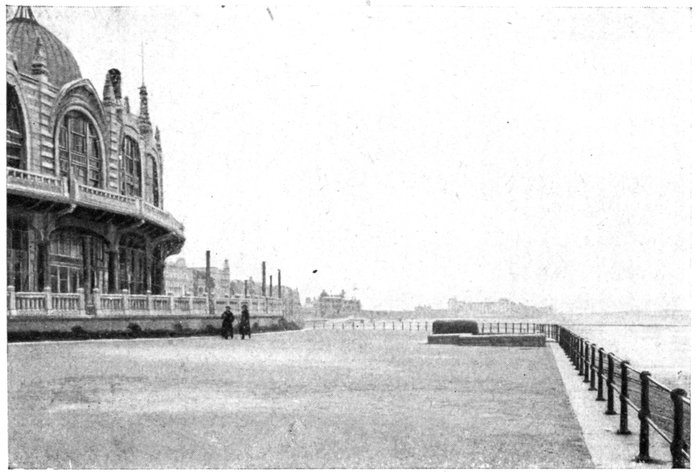
Ostend.
The Sea Wall.
On the left:
The Kursaal.
On the right:
Concrete Shelter
Further on (to the left)
The Chalet Royal
In the background:
Mariakerke.
The Chalet Royal.
This ensemble of light constructions occupies a fine dominating position.
Instead of levelling the dune, the side facing the sea was consolidated with
masonry-work.
The opposite side of the hill is laid out with terraced gardens, through
which winds the road leading to the Chalet. The latter comprises two
large pavilions connected by a central gallery.
In the large square, situated in the rear, were collected the bathing
cabins, in which refugees from all parts were sheltered during the first
months of the war.
Take Rue Royale, Boulevard van Iseghem, then the road on the left leading
up to the dike, near the Kursaal. (Vehicular traffic on the dike is prohibited
from 9 a.m. till midnight.)
The Sea Wall.
Here the dike is separated by some 150 yards from the line of the dunes,
being bounded on the west by the terrace of the Kursaal, on the east by a
perré, rounded off in front of the port jetties. The effect of this bold promontory,
which seems to defy the waves, is most striking.
The eastern end, on which stands the old lighthouse (now a semaphore
station), was built at the beginning of the 19th century. It is now a
promenade bordered with fine buildings, some eighty yards in length by
thirty in width. The masonry embankment rises thirty feet above the
foundations and is protected by four massive breakwaters.
At low water, only about 200 yards of the beach is uncovered, or about
half as much as at the Western Baths, where the shore forms an angle
immediately to the left.
In front stretches the New Western Dike, set further back than the
old one, and prolonged as far as Mariakerke. The sea-wall at Ostend has
thus a total length of 3½ kms.
The Sands.
Each summer, before the War, the Western Beach, with its vast expanse
of golden sands, its countless bathing-machines and coloured tents, offered,
in the bright sunshine and clear air, an extraordinarily animated and
gay scene.
[Pg 63]
The Eastern Sands, at the other end of the dike, in front of the wooden
pier, although less popular, were nevertheless crowded with bathers during
the season.
The Kursaal.
From 1831, when Ostend-Bains was "discovered", until 1875, the Kursaal
stood on the old brick-paved dike. It was a modest construction (now at
Malo-les-Bains) but had, till then, sufficed for the town's needs. In 1875,
the new sumptuous Kursaal was begun on its present magnificent site.
The building, designed by the architects Naert and Lauwereins, covers
with its grounds an area of about three acres. Originally, its general
aspect was somewhat bizarre, and reminded one of a gigantic turtle basking
in front of the sea. The alterations since carried out at different times,
particularly the ceramic ornamentation, has considerably improved its
original appearance.
Its curved façade follows that of the dike, the latter forming solid foundations.
The façade consists of a covered terrace, thirty feet wide, extending
round the central rotunda. The latter, elliptical in shape, is 200 feet long,
120 feet wide and 75 feet high, and forms an immense hall capable of holding
some 5,000 people. Symphony concerts are given there.
Return by the path on the west side and take the broad Avenue Léopold,
opposite, ornamented with gardens, to Leopold Park (see plan, p. 60.)
Leopold Park.
Leopold Park was laid out in former days on the site of the old fortifications,
near the Western Gate, the glacis of the bastions being used to
break the monotony of the level ground.
After visiting the park, return to Avenue Ch. Janssens, which separates
it from Boulevard Léopold, and take same on the left. In Place Léopold,
take Chaussée de Thourout, on the left, then Rue de Leffingue as far as the
entrance to the "Tirpitz" Battery, (photos below and p. 64), situated on
the right some few hundred yards outside the town.

The Tirpitz Battery, photographed from Allied aeroplane, July 31, 1916
[Pg 64]

General view of the powerful
Tirpitz Battery.
The background: Ostend.
Inset:
Breech of one of the Guns.
The Tirpitz Battery.
This powerful battery has four 11in. armour-protected guns, mounted on
circular tracks on hollow platforms of masonry about 46 feet in diameter.
The shelters behind the guns were destroyed. The battery was protected
by trenches and barbed-wire entanglements.
On the left, facing the sea, are screens which masked the fire of the guns
from the land observation-posts. In front of the right-hand gun was the
post of commandment.
The guns of this battery were being built by Krupps in 1914, to the
order of the Belgian Government, for the forts of Antwerp.
Return to the town by Rue de Leffingue, Rue du Chemin-de-fer, and Quai
du Châtelet; the latter skirts the 3rd and 2nd Commercial Docks and ends
at Place Vanderzweep, near the station (see plan, p. 60). Cross the bridge,
on the left, between the 2nd and 1st Docks, then turn to the right along Quai
de l'Empereur.
The Place du Commerce is next reached, at the end of which stands the
Church of St. Peter and Paul.
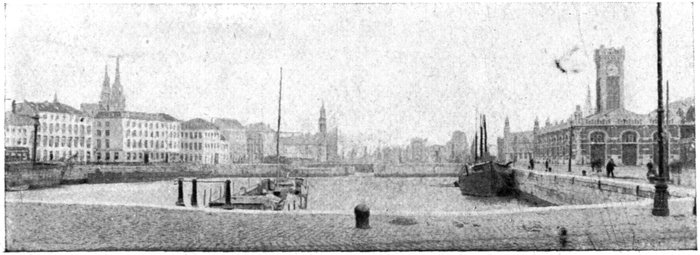
Dock No. 2, Church of St. Peter and Paul (left) and the Station (right.)
[Pg 65]

Ostend. The Church of St. Peter and St. Paul.
The modern Church of St Peter and Paul stands on the site of a former
church of that name (1717) which was burnt down in 1896, with the exception
of the campanile still standing behind the new building.
At the foot of the new choir is an allegorical group in white marble (by
Fraikin), to the memory of Louis-Marie d'Orléans, first Queen of the
Belgians and wife of Léopold I, who died at Ostend in 1850.
Opposite the church, facing the port, is the Maritime Station, which suffered
severely from the aerial bombardments.
The port of Ostend.
The port of Ostend dates back to the 15th century. In 1445, Philippe-le-Bon
authorised the inhabitants of the town to make an opening in the
dike, in order to construct a fishing harbour. The latter was situated
opposite the present
port, i.e. to
the west, near Mariakerke.
At the
end of the following
century it
was moved eastwards,
the sea having
opened up a
passage on that
side, in consequence
of the levelling
of the dunes
for the construction
of the fortifications.
How[Pg 66]ever,
the maritime installations which, until the end of the last century,
formed the port of Ostend, dated from the time of the Emperor
Joseph II. They were completely transformed and considerably extended
in 1898-1914, the work being almost complete when the war broke out.

The
Maritime
Station.
(Ph. Nels).

Ostend.
Place
d'Armes
and
Hôtel-de-Ville,
(Photo
Nels.)
The new vast outer-harbour communicates with the sea by means of
a wide channel enclosed between two open-work piers. The channel is
also connected by a powerful lock to an immense modern impounding-dock,
over 200 acres in extent. The tide supplies the water necessary for
flushing the channel clear of sand.
The landing-stage of the Maritime Station borders on the outer harbour
where the boats plying daily between Ostend and Dover were moored.
Words cannot describe the scenes which took place here during the first
half of October 1914, after the fall of Antwerp. At the approach of the
German armies, panic-stricken crowds of refugees filled the stations and their
approaches to overflowing, in frantic endeavours to get on board the ships
that were to take them to Britain.
Quai de l'Empereur is prolonged, beyond Place du Commerce, by Quai des
Pêcheurs which skirts the Minque (or Fish Market) and the Bassin des
Pêcheurs.
The Bassin des Pêcheurs (Fishing Dock) is connected with the outer-harbour,
which precedes the channel. Near by is the "Minque" (Fish-Market),—a
circular building in which the fish is sold by auction daily,
the proceedings being announced by the ringing of a bell.
During the fine season the natives fish mainly along the English and Dutch
shores, but go as far as the entrance to the Channel in the winter. Their
boats are of the trawler type, fitted with conical drag-nets, the mouths
of which, thirty to forty feet wide, are kept open by cross-stays. The nets
are dragged along the bottom of the sea.
Keeping along the dock-sides, the tourist next reaches the old lighthouse
at the end of the dike. Take Boulevard Van Iseghem on the left, then Rue de
Flandre on the left, in front of the theatre, leading to the Place d'Armes, in
which stands the Hôtel-de-Ville (see plan, p. 60.)
The Hôtel-de-Ville, built in 1711, and restored later, after mutilation,
occupies the whole of one side of the Place d'Armes, in the centre of the
old city. The long façade was flanked at either end by high towers,
only one of which remains.
To leave Ostend, for the second day's itinerary (Ostend-Zeebrugge-Bruges)
take Rue de la Chapelle (continuation of Rue de Flandre) in front of the Hôtel-de-Ville
(See, p. 60[Pg 67].)
Second Day
Ostend Zeebrugge
Bruges

Itinerary for the Second Day.
Leave Ostend by Rue de la Chapelle, which passes in front of the Hôtel-de-Ville
(pp. 60 and 66) and leads to Place Vanderzweep. In this square, at
the end opposite the Bassin du Commerce, take Avenue de Smet de Naeyer,
which leads to the Parc Marie-Henriette.
Situated south of the town, between the two railways ending at each
of the two stations, is Marie-Henriette Park, which owing to its great size,
numerous winding alleys, clusters of trees, and artificial lakes with pleasure
boats, was often deservedly called the "Bois de Boulogne". The long
Avenue de la Reine connects it directly with the Western Dike; on the
other hand, it borders on the new maritime installations.
Cross the two bridges over the lateral canal, then the railway and maritime
lock; take the first street on the left, which passes over the Ghent-Ostend canal
and the sluice-gates. Take Chaussée du Phare, on the left, then the first
street on the left, opposite Rue Mansveld, to the Oyster-Beds.

Ostend. The Monumental Bridge. Exit for Zeebrugge.
[Pg 68]

Panorama of Ostend seen from the old lighthouse.
Ostend oysters, of world-wide repute among gourmets, are not natives
of these shores. Gathered from the rocks on the English and Brittany
coasts by the Ostend fishing-boats, they are fattened by a special process
in the Ostend oyster-beds. The latter, situated in the lighthouse quarter
communicate with the outer-harbour. They consist of reservoirs divided
into compartments with planks, in which the sea-water, renewed every
day, deposes its slimy sediment. During the War, the oyster-beds were
closed.
Taking Chaussée du Phare again on the left (see plan, p. 60), the tourist
reaches the site on which the lighthouse used to stand, now a heap of ruins.
Built in 1859, its round tower, 175 feet high, showed a fixed white light.
Behind is the old Napoleon Fort. Facing the lighthouse, at the end of
the sluice dock, stands the Powder Magazine, a kind of fort where the
Germans had two batteries.
Tourists may go round the powder magazine by following the dike which
is terminated by the Eastern Wooden Pier. It was at the end of the latter
that the British sank the "Vindictive" on May 11, 1918.
The Blocking of Ostend Port.
On April 21, the British Admiralty undertook to block up the ports of
Ostend and Zeebrugge.
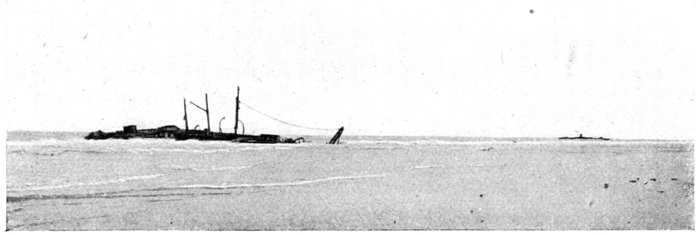
British Cruisers "Sirius" and "Brilliant" sunk to the east of the wooden
pier at Ostend, April 22, 1918.
[Pg 69]
Under the command of Commodore Hubert Lynes, the flotilla left
Dover at the same time as the one which was to block up Zeebrugge.
The Ostend flotilla was composed of the cruisers Sirius and Brilliant
(Commodore Godsal), loaded with concrete, which were to be sunk at the
entrance to the port. Destroyers, scouts and motor-boats were to reconnoitre
the way and pick up the crews of the blockading ships. Lastly,
smoke-boats provided a protecting screen of smoke, which hid the flotilla's
movements from the enemy.
When twelve miles from Ostend this flotilla parted company with that
bound for Zeebrugge.
The smoke screen hiding the Sirius and Brilliant was swept away
by a sudden veering of the wind. The enemy's gunfire had extinguished
the lights which were to guide the two cruisers, and the latter thus ran
past the Stroom Bank buoy which should have marked the entrance to Ostend
but which the Germans had displaced. They were therefore sunk
to the east of the stockade.

The Vindictive
undergoing repairs after her return from Zeebrugge, previous to leaving for Ostend
where she was destined to finish her career.
This operation having proved unsuccessful, it was decided to make
a further attempt, which was again entrusted to Commodore Lynes. This[Pg 70]
time the blockading ship was the Vindictive (Captain Godsal), and the Air
Service took part in the enterprise. On the night of May 9, the weather
being favorable, the Vindictive steamed towards a limelight placed by a
motor-boat on the site of the Stroom Bank buoy.

Napoleon
Fort, and
the road
leading
to the
Hindenburg
Battery
(on the left.)
Two motor-scouts torpedoed both ends of the wooden piers, at which
signal the whole of the British artillery opened fire, and was immediately
answered by the German guns. A thick fog soon swallowed up everything.
The Vindictive had to be led by scouts and, notwithstanding the death of
her commander, and the numerous shells which hit the ship, Lieutenant
Crutchley was able to carry out the manœuvre, swing the cruiser across
the channel, and blow her up. The crew were picked up by a scout, and the
flotilla put back to Dover.

The Hindenburg Battery, north-east of Ostend.
[Pg 71]

Observation-Post of Coast
Batteries.
Upper photo: General View of
the Post.
Near the skyline: one of the two
British cruisers sunk during the first
attempt to bottle up Ostend Harbour.
Middle photo: Exterior View of the
Observation-Post.
Lower photo: Interior View of the
Observation-Post.
[Pg 72]

By-road
(see arrow)
leading
to the
Jacobinessen
Battery.
The Germans were eventually able to displace the Vindictive and
partly free the passage.
Return via Chaussée du Phare to Place de l'Ecluse, turn to the left into
Boulevard du Congo, which crosses the new eastern quarter of Ostend (see plan,
p. 60.)
Just outside the town, a short distance before reaching the "Hôpital" (to the
left of the road), turn to the left and skirt the left side of the "Hôpital", as far
as the "Hindenburg" Battery, consisting of four 11in. guns on semi-circular
concrete platforms.
In front of this battery is the Old Napoleon Fort, which the Germans
turned into a Casino during the war. Some of their mural paintings may
still be seen in the rooms.
Farther on, is the post of commandment of the "Hindenburg"
Battery.
Return to the road and continue in the direction of Blankenberghe.
Beyond Milestone No. 6, which bears the inscription "Le Coq 5 km. 1",
there is an observation-post, on the left, with telemetric posts and machine-gun
shelters (photos, p. 71).
On the coast, some distance ahead, may be seen one of the cruisers
which were to have blocked the port of Ostend.

One of the Deutschland (Jacobinessen) Battery's Guns.
[Pg 73]

The "Deutschland" or "Jacobinessen" Battery;
One of the guns, with shelter for the men and munitions. Below: 1. Breech of the gun;
2. Electric gear for laying; 3. Munitions Shelter; 4. King Albert and President
Poincaré visiting the Battery.
[Pg 74]
On the road to Blankenberghe, at the point shown by an arrow in the photo
on p. 72, take the road on the right leading to the "Deutschland" Battery,
also known as the "Jacobinessen" Battery (photos, pp. 72 and 73).
This was the most powerful battery on the Belgian coast. Armed with
four 15in. guns, it was used to bombard Dunkirk.
Grouped in pairs, these naval guns, mounted on bridges, were installed
in concrete pits about seventy feet in diameter. The right-hand gun only
was protected with armour.
The gun laying was effected by means of electric motors. Near each gun
immense shelters of reinforced concrete were used to store the shells, while
the large shelter between the two groups was probably the post of commandment.
Camouflaging of barbed-wire covered with branches of trees may still
be seen hanging above the battery.
The latter was protected by deep lines of barbed wire and infantry defence-works.
Return to the Blankenberghe road and pass through the village of Le Coq
(Flemish: de Haan.) On the top of the last turretted house on the right, is an observation
post, and opposite, on the top of the dune, a searchlight. On the dike
are two 3in. anti-aircraft guns, and in the surroundings, numerous shelters.
Further on, to the left, are a lighthouse, and on the high dune, an observation-post.
Pass through Wenduyne (4½ kms.) arriving at the "Herta" Battery,
on the left of the road. This battery comprises four 8in. guns. A little further
on is the "Hafen" Battery, comprising four 3½in. guns. Blankenberghe
(4 kms.) is reached by going between the Fishing Dock and Impounding
Dock.
Blankenberghe was one of the most popular resorts on the Belgian coast.
On the dike, the Kursaal, erected in memory of Lieutenant Lippens and
Sergeant de Bruyne, both natives of Blankenberghe, who were killed
in the Congo in 1893, and the Pier (Promenade) are of interest.

The Kaiserin Battery, to the east of Blankenberghe.
In the background: The houses of Blankenberghe.
[Pg 75]
Follow Avenue Smet de Naeyer as far as the station, then turn left along Rue
de l'Eglise, to the steps leading up to the dike. If it is not desired to visit
the dike, turn to the right along Rue de l'Eglise and Rue des Pierres, then
follow Avenue Jules de Trooz, and turn left along Avenue du Littoral. There
are tram-lines along both avenues. Tourists who go as far as the dike should
take Rue du Casino (on the right, at the top of Rue de l'Eglise), then
Avenue Rogier which joins up with Avenue du Littoral.
Beyond Blankenherghe the road is bordered, on the left, with fortifications
and batteries. Follow it as far as Zeebrugge-Plage (4½ kms.)
The following batteries will be passed on the way:
The "Kaiserin" Battery, with four 6in. guns; the "Mittel B" Battery,
with four 4in. long guns on concrete platforms, adjusted for firing against
aircraft (this battery is on the top of the dune, with shelters below); the
"Groden" Battery, comprising four 11in. howitzers.
Lastly, near the port of Zeebrugge, is the "Zeppelin" Battery, of four
4in. guns. The entrance to it is situated a short distance before reaching
Zeebrugge-Plage.
At Zeebrugge-Plage (Beach), near the Pilots' House, turn to the left
alongside the railway, to the mole which bounds the Port of Zeebrugge
on the west (photo below, and sketch-map on page 77).
The port is situated about ten kilometers from Bruges, with which it
is connected by a ship canal running straight across the littoral plain.
This canal, which is about 230 feet wide and 26 feet deep, is accessible
to large ships. It cost forty-two million francs to construct. Communication
with the roadstead is obtained by means of an inner-harbour which
is provided with locks and sluice-gates.
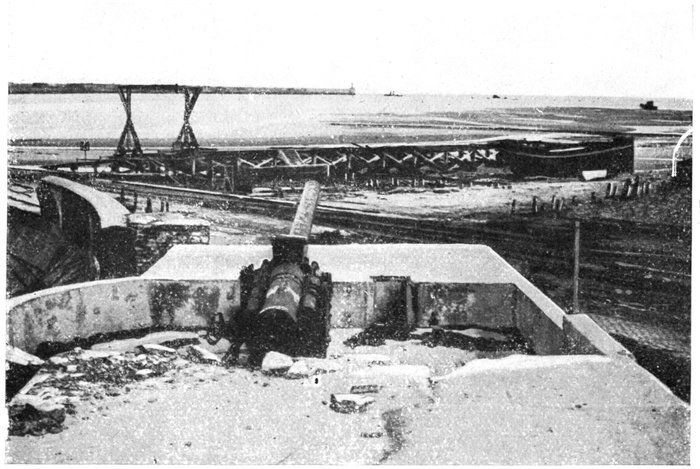
Entrance to the Mole at Zeebrugge (See sketch, p. 77.)
At the entrance to mole: 6in. guns on concrete platforms. To the right, at the end of
the Mole: German Destroyer sunk by the British during the blockading operations
(photo, p. 78.)
The port is protected by a semi-circular jetty or mole which stretches[Pg 76]
out into the sea for a distance of about two kilometres; an elevated side-walk
leads to the end of the jetty. The latter, built of blocks of concrete
each weighing three thousand tons, is divided into four parts: the first,
which spans the beach, is solid; the second is of open-work, to prevent
the port becoming choked with sand; the third comprises the wharves
proper, and forms the terminus of a special railway siding; it is solid and
has an elevated walk running along the left hand side; the fourth, or
Lighthouse Jetty, is also solid and acts as a break-water. This immense
undertaking, begun in 1893, was completed ten years later, and the new
port, on which great hopes were set, was solemnly opened, amid popular
rejoicings, by King Leopold.

The Wharves on the mole
beyond the open-work
portion of the latter
The Lighthouse Pier
seen in the photographs
on page 81.
The Mole
of Zeebrugge.
An assemblage of aeroplane
photographs taken in 1917.
On the left, a number of seaplanes are visible.
German warships moored alongside the quay.
THE BLOCKING OF THE
PORT OF ZEEBRUGGE.
April 22,
1918.
In October 1914, the Germans made a "pirates nest" of the port, which
was consequently attacked unceasingly by British ships and Allied aeroplanes.
The most important of these attacks was that which resulted in
the blocking of the port.
Motor-cars may go along the mole as far as the
end of the wharves. See text and photographs on
pages 80 and 81.
In spite of the enemy's formidable defences
around Zeebrugge, the British determined to block
that port, at the same time as Ostend (See page 68).
The operations, carefully planned in all details,
were extremely perilous on account of the minefields,
the nature of the landing-places (unmarked
by any lights), and the difficulty of finding one's
bearings near a coast where the dunes of varying
heights are indistinguishable one from another.
The enterprise was entrusted to Vice-Admiral
Keyes, Commander of the Naval Forces at Dover.
The attacking flotilla was composed as follows:
Three old cruisers the Iphigenia (Lieut. Billyard-Leake),
the Intrepid (Lieut. Stuart Bonham-Carter)
and the Thetis (Captain Sneyd),
which, loaded with concrete, were to be sunk in
the channel.
The protected cruiser Vindictive (Capt. Carpenter),
was armed for an attack on the mole;[Pg 77]
sailors and marines were to land, destroy the guns, drive back the Germans,
and create a diversion, thus enabling the blockading ships to carry
out their mission.

The Attack on Zeebrugge.
- The "Vindictive" alongside the mole,
on which the Marines disembarked.
- The "Daffodil" holding the "Vindictive".
- The "Iris" alongside the mole.
- The "Thetis" sunk in front of the
Channel.
- The "Intrepid" and "Iphigenia"
sunk in the Channel.
- Submarine blown up alongside the
open-work pier.
- 6in. guns at entrance to mole (photo,
p. 75.)
- Church and cemetery in which several
of the British killed during the operations
were buried (photo, p. 80.)
Two ferry-boats: the Iris and
Daffodil, armed for landing operations;
two submarines, loaded
with explosives, to attack the mole;
destroyers to defend the flotilla
against enemy attacks; launches
and motor-scouts to pick up the
crews of destroyed or sunken vessels,
and smoke boats.
Vice-Admiral Keyes was on
board the Warwick. All the men
were picked volunteers of tried
courage and energy.
The attack, several times postponed
owing to the unfavourable
weather, was carried out on April
22, 1918. The flotilla put to sea
during the day. When about
twelve miles off Zeebrugge, the
boats parted company, each taking
up its assigned position. The Vindictive,
Iris and Daffodil advanced
behind a smoke screen to within
a few cable-lengths of the mole,
when a change of wind dispersed
the smoke, leaving them fully
exposed to view. Enemy sirens
immediately gave the alarm.
Searchlights, rockets and star-shells
lit up the scene, and the air was
immediately filled with the roar of
artillery and the crackling of
machine-guns.
Amid bursting shells, and swept
by machine-gun fire, the Vindictive
succeeded in anchoring along[Pg 78]side
the mole, but her deep draught and the surf prevented her remaining
in position, until held by the Daffodil. Most of the eighteen gangways
were smashed by the cruiser's rolling. The Iris was also in difficulties,
her grappling irons being too small to catch hold. Two officers,
Capt. Bradford and Lieut. Hawkins, climbed up the side of the mole and
endeavoured to fasten the grappling irons. Both were killed. A landing
was nevertheless effected, and in spite of heavy losses and the death of
Colonel Elliot and Captain H. C. Halahan, the sailors and marines advanced
along the mole, under very heavy fire, and for an hour destroyed the
enemy's organisations, magazines, sheds, machine-gun posts, etc.

Zeebrugge. One of the German destroyers sunk by the British.
(See photo, p. 75.)

Zeebrugge. The "Intrepid" and "Iphigenia", sunk in the Channel.
Beyond, in the harbour: the "Thetis" (See sketch, p. 77.)
Meanwhile, the blockading cruisers had entered the port and were steering[Pg 79]
for the channel, despite the violence of the bombardment. The Thetis
was leading, but her propeller becoming entangled in a net, she was unable
to advance further, and her crew blew her up on a sandbank in front of the
channel. The Intrepid, followed by the Iphigenia, reached the channel,
placed themselves across it and were then blown up. The crews were
picked up by the motor-boats.

The funnels of the "Vindictive", on her return from Zeebrugge.
After being summarily repaired, the "Vindictive" accomplished her last exploit, by
bottling up Ostend Harbour on May 11, 1918. (See page 68.)
Just at the time when these operations were being completed, Lieutenant
Sandford's submarine succeeded, despite the terrific artillery fire, in reaching
the open-work part of the mole, where she was blown up, shooting
flames to a height of nearly 5,000 feet, and making a breach over 60 feet
wide in the jetty. A motor-boat picked up her crew.
A German torpedo-boat and the Brussels were sunk by motor-launches.
(The "Brussels" was captured by the Germans on June 24, 1916. Her
commander, Captain Fryatt, was shot on July 27, for having rammed the
German submarine U-33).
[Pg 80]

The open-work portion
of the Mole destroyed
by the British submarine,
(Lieut. Sandford).
Inset: temporary
bridge built by the Germans
and destroyed by them
before their retreat.
The Vindictive's siren recalled the landing-party, who succeeded in
bringing back most of their killed and wounded. The flotilla then weighed
anchor and returned to Dover.
The operation had succeeded as well as could be expected. The two
cruisers, although displaced slightly later by the Germans, blocked
the channel, making it impossible for ships of other than light draught to go
through. The Thetis also helped to obstruct the entrance to the channel.
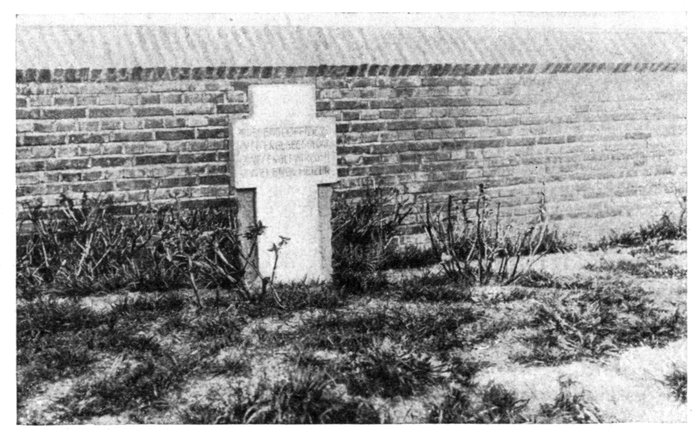
British Graves in Zeebrugge Cemetery.
The cross bears the following inscription (in German): "Three English officers, seven
English marines, two English sailors, two English stokers".
[Pg 81]

The end of the Wharves and the Lighthouse Pier.
The upper view is looking from the lighthouse; the lower view takes in the whole of the
roadstead. See photos, pp. 76 and 77.

A nest of submarines with their shelters
of reinforced concrete.
These were the only shelters, built by the Germans at Zeebrugge,
which they failed to destroy before retreating.
Cars can go to the end of the wharves on the mole. Right and left of the
entrance to the jetty are two 6in. guns on concrete platforms (photo, p. 75).
Next comes the open-work part, repaired by a temporary bridge built
in the first instance by the Germans to replace that part of the jetty destroyed
by Lieut. Sandford's submarine, and later rebuilt by the Belgians,
after the Germans had destroyed it previous to retreating (photos, p. 90). The
tourist now arrives at the mole, on the right side of which are the wharves
with their sidings,
sheds and cranes
which were damaged
either by air-raids
and the British
attack, or by
the Germans previous
to their retreat.
On the left are
concrete shelters
which were used
by the gunners
for storing shells,
etc. During the
German occupation,
the enemy's
torpedo-boats and
submarines were[Pg 82]
moored alongside the wharves. Along the elevated side-walk are a battery
of four 3½in. guns and a number of 6in., 4in., 3in. and 1½in.
guns. The entrance to the channel, with the sunken cruisers and the
"Thetis" stranded in front of them, can clearly be seen from the side-walk.

The four guns
of the
"Friedriechsart"
Battery.
Return to the road and before crossing
the canal take the road on the left which
leads close to where the "Intrepid" and
"Iphigenia" still lie. The work of
clearing the entrance to the canal has
begun.
Cross the Bruges Canal by the locks,
and proceed to Zeebrugge (2 kms.), an
important town which grew up around
the port. On the left, in the cemetery
behind the church, are the graves of several of the British who were killed
in the expedition against Zeebrugge (photo, p. 80), and of the aviators
who were brought down in the neighbourhood.

The
"Friedriechsart"
Battery.
One of the
guns in
casemate,
and shelters.
On leaving Zeebrugge, notice the "Friedriechsart" Battery, on the right[Pg 83]
armed with four 6½in. naval guns in closed turrets, turning on circular
rail tracks mounted on concrete platforms. Between the guns are ammunition
shelters connected with the guns by lifts, as on a battleship. In front
are infantry defence-works which extend on both sides as far as the Bruges
and Leopold Canals.

The
"Freya"
Battery.
On the left:
Heyst-sur-Mer.
On the skyline:
Zeebrugge Mole.
Cross the Léopold Canal; immediately beyond, on the left, is the "Kanal
B" Battery, armed with 3½in. guns, and on the right a battery of
3in. anti-aircraft guns.

"Augusta" Battery
situated between
the "Freya" Battery and
Duinbergen, the first houses
of which are seen in the
photo. In the inset:
One of the battery's guns.
[Pg 84]

Duinbergen.
A, B and C: German
Observation-Posts on
the house-tops. (Seen
from the observation-post
on the Dune
reached by following
the arrow shown in the
lower half of photo).
Continuing along the road, the tourist next reaches Heyst-sur-Mer (2 kms.)
skirting the hotels and villas on the dike. Beyond the last houses of Heyst,
on the right, is the "Freya" Battery, armed with four 8in. protected long-range
guns, on circular concrete platforms. Between the left-hand gun and
Heyst are two large ammunition shelters; the gunners' shelters are behind.
This battery is prolonged by the "Augusta" Battery, armed with three
6in. guns on concrete platforms. There is a searchlight on the dike in
front of the two batteries.

Kaiser-Wilhelm II
Battery,
to the west of Knocke (seen in
the upper half of photo).
Lower photo: the entrance
to the battery, near the
windmill.
The road next passes
through Duinbergen
(1½ kms.), where the
Germans had observation-posts
on the roofs
of three houses. In the
village, turn to the right,
at the corner of Pauwers[Pg 85]
Hôtel (photo, p. 84) coming out behind the square which stretches as far as
the dike, near a concrete observation-post, built on the top of a high dune,
and commanding a fine view over the sea (Photo, p. 84).
Keep along the street in front of the square, going away from the sea; about
100 yards beyond the tram-lines, turn left towards Knocke (2½ kms.)
Turn left, before reaching the church, to the mill, near which is the entrance
to the "Kaiser Wilhelm II" Battery. The latter is armed with four
12in. long range guns, mounted on bridges, and pivoting round circular
tracks in concrete pits, by means of electric motors (Photos, p. 84).
If it is desired to go as far as Knocke-sur-Mer (1 km.), turn left, beyond
the church, along Boulevard de Lippens.
This is the most northern seaside place on the Belgian coast. Its church
(St. Margaret's) possesses a 15th century tower. During the war, the Germans
transformed several houses on the dike into concrete shelters.
Return to Knocke, proceeding thence to Heyst along the road previously taken.
Enter Heyst (3 kms.) by the Chaussée de Knocke; take Rue du Kursaal, on the
left, then the Ramscappelle Road, on the right, bearing left again 400 yards
further on. 2½ kms. beyond Ramscappelle-lez-Bruges take the road on
the right and cross the Leopold Canal.
Go through Dudzeele village, to the right of which are the remains of a
battery position, and further along the road, several concrete shelters.
Bruges (18 kms.) is entered by the Chaussée de Dudzeele. Take the Fort
Lapin, on the left, then cross the bridges, on the right, to the Plaine des
Ecluses.
Beyond the latter, follow Rempart des Bassins, then, on the left, Rue du Calvaire,
prolonged by Rue St. Claire, Rue St. Georges and Rue Flamande,
coming out at the Grand'Place (See plan between pp. 88 and 89.)

Bruges,
seen from
Quai
du Rosaire.
In the
background:
The Belfry.
(See p. 97.)
[Pg 86]

Bruges. Triumphal Entry of the Belgian Army, with King Albert and
Queen Elizabeth at their head, on October 25, 1918.
Origin and Chief Historical Events.
A burgh and a fortified bridge (whence the name of "Bruges" ("Brugge"))
on the Reye, a brook since absorbed by the canals,—such was the origin
of the town.
In the 9th century Baudouin-Bras-de-fer, first count of Flanders and
vassal of the French King replaced the original establishment with a fortified
castle, around which, in spite of civil discords, quarrels between the
rulers and their turbulent subjects, dissensions between the vassal and his
suzerain, and rebellions by those two powerful Flemish communes—Ghent
and Bruges—the town grew and prospered. These troubles were marked
by sanguinary episodes, chief among which were the "Bruges Matins"
(1302) in which thousands of the "Gens du Lys" (Leliaerts) partisans of
France, lost their lives, and shortly afterwards the famous "Battle of the
Golden Spurs", in which the flower of France's chivalry, lured into the
Groeninghe Marshes, was annihilated by the Flemish pikemen (clauwaerts)
led by Breydel the butcher, and Coninck the draper.
The era which followed this crisis was one of great prosperity for Bruges,
then a vast emporium of European trade, being in close relation with London,
Genoa, Venice, Augsburg and the Hanseatic towns. Wealth abounded.
The rich foreign merchants built sumptuous mansions, several of which
still exist. Bruges attained the height of its prosperity in the 15th century,
under Burgundian rule. Favoured by the long reign of Philippe-le-Bon,
"the Great Duke of the West", the arts, today the glory of the old city,
flourished exceedingly.
Decadence set in, chiefly owing to the retreating of the sea and the gradual
filling up of the creeks and harbours with sand. Trade steadily declined,
whilst in the 16th century, political and religious troubles hastened the[Pg 87]
downfall of the city. The population of 200,000 dwindled away to 50,000,
and at last the place came to be known as "Bruges-la-Morte".

Bruges. The Governor of Flanders and the Burgomaster
of the City welcoming King Albert, Queen Elizabeth and Prince
Leopold in the Grand'Place.
Under the Republic and the Empire, the city, under French domination,
became the capital of the Department of the Lys, and later, under Dutch
rule (1815-1830), of Western Flanders. When, later, the kingdom of Belgium
was constituted, it retained this rank.
Since that time, Bruges with her melancholic chimes has remained a quiet
old-world place, the delight of lovers of art, who each year come to admire
her treasures, amid the charm of quaintly picturesque scenery.
The boundaries of the city have remained unchanged since the time when
Bruge's prosperity was at its height. The area of the town being the same
as in the 14th century, it follows that the present-day population of 50,000—all
that remains of the former 200,000 inhabitants—has plenty of elbow-room.
However, the numerous open spaces and gardens in no way detract from
the æsthetic appearance of the place. In shape an oval, stretching from
the south-west to the north-east, the town is surrounded by ramparts and
a wide exterior moat, except on the north (between the Gates of Ostend
and Damme) where they were demolished at the beginning of the present
century, in order to connect up directly with the new ship canal. Parts
of the ramparts have been transformed into boulevards, promenades and
gardens. Of the numerous windmills which used to form a picturesque
girdle round the city, only two, situated near the Sainte-Croix Gate,
remain.
At the beginning of the present century, when the ship-canal from Bruges
to Zeebrugge was opened, the "dead" city made an effort to revive her
ancient prosperity, but the irony of fate willed that the new port should
mainly serve the German invader. On October 13, 1914, amid the confusion
which followed the fall of Antwerp, and whilst the remains of the
Belgian Army were falling back on the Yser, the Germans entered Bruges,
and there established the reign of terror under which Belgium suffered for
four long years. Happily, Bruges, like Ghent and Brussels, came out of
the War practically unscathed.
[Pg 88]

King Albert and Queen Elizabeth leaving
the Hôtel Provincial (October 25, 1918.)
From October 14, 1914
to October 19, 1918,
Bruges was occupied by
the Germans, with Admiral
von Schroeder as
Military Governor.
Requisitions to the
amount of some sixty
millions of francs were
levied; the factories
were emptied of their
machinery, and the
warehouses of their raw
materials.
The bombardments
did little damage. The
maritime quarter, in
which were the Imperial
workshops, alone received
a number of aeroplane
bombs.
It was in this strictly
guarded arsenal that the
Germans assembled and
repaired their submarines.
Armour-protected
shelters and concrete-covered
docks for the
submarines not on active
service, provided security
for the enemy's
intense activities. Immense
reservoirs of crude
oil furnished the boats with fuel. Before leaving, the Germans destroyed
these works. The floating-docks, drags, cranes, and port machinery, etc.,
belonging to Belgium, were wrecked. Sunken hulls blocked up the channels.
Huge quantities of stores, including girders, reinforced concrete, sand, etc.,
were left behind on the wharves.
After stripping the place of everything that could be carried off, after
attempting to sell several captured boats which had been brought in there,
and after blowing up the bridges, the enemy left the town. Through some
mysterious and powerful intervention, the chimes in the belfry were left
untouched, and as the Germans hurriedly departed, a peal rang out joyously.
Flags and banners were taken from their hiding-places and hung in the
streets and squares. "Bruges-the-dead" became "Bruges-the-living-and
joyful".
On October 25, 1918, amid indescribable enthusiasm, and to the strains
of "La Brabançonne" and "La Marseillaise", rung out on the old belfry
chimes, King Albert, Queen Elizabeth and Prince Leopold, accompanied
by the General Staff, General Degoutte and Admiral Ronarc'h, re-entered
the liberated city.
[Pg 89]
Third Day.
A VISIT TO BRUGES.
See Coloured Plan between pp. 88-89.
To facilitate visiting the city, two excursions are indicated, both of which
start from and return to the Grand'Place.
In Belgium, the churches are generally closed from noon to 2 p.m. The
chapels, in which the works of art are kept, can be visited at specified hours,
for a small fee. The same applies to the Hôtel-de-Ville.
Before starting to visit Bruges, obtain particulars from the Bureau Officiel
de Renseignements, Grand'Place, underneath the Belfry (3 minutes from the
station).
FIRST EXCURSION.
The Grand'Place.
The Grand'Place or Grand Marché is in the centre of the city. The "Halles"
occupy the south side, and the Hôtel du Gouvernement Provincial and
General Post Office the western side. On the northern side is a row of
remarkable gabled houses (photo below), while to the east, at the corner
of the Rue St. Amand, stands the Hôtel Bouchoute which, in 1839, was
surmounted with a metal ball indicating the meridian line. In the centre
is a monument by the sculptor Paul de Vigne, erected in 1887 to the memory
of the famous communists Breydel and de Coninck.

Bruges. Ancient houses in the Grand'Place.
[Pg 90]

General View of Bruges, seen
from the top of the Belfry.
A. Ostend; B. Church of St. Jacques; C. Blankenberghe; D. The Theatre;
E. Water-Works of Zeebrugge; F. Zeebrugge Canal; G. Port of Bruges;
H. Heyst; I. Duinbergen;
J. Church of St. Gilles; K. Knocke.
The Halles and Belfry.

The Belfry. In front: The Statue to
Breydel and Coninck.
It is this edifice—an eloquent
witness of the city's
past grandeur and symbol
of the ancient prosperity of
the "Queen of the West"—which
characterises Bruges.
The building measures 270
feet in length by 110 feet
in width. The low galleries
with groined vaulting on
the ground-floor, contain
an archæological museum,
whilst those on the first
floor are used for exhibition
purposes.
The Belfry, in the centre
of the façade, is 264 feet
high, and comprises two
massive, square, superimposed towers, decorated
with pinnacles connected
by a balustrade. Above
rises a third octagonal tower
supported by flying buttresses.
This last story,
which contains the famous
peal of bells, was added
towards the end of the 15th
century. It was surmounted,
first with a spire, and
later, after the spire was[Pg 91]
burnt, with a triple campanile, destroyed by lightning in 1741. A balustrade
now crowns the tower.
The Renaissance statue of the Virgin, on a stem-like ornament over the
main doorway (1819), replaced the original one which was broken during
the Revolution (1793). Above is a bretèche, from which public announcements
were made.

The Cathedral
of St. Saviour
Rue du Beffroi.
The "Halles" date from the 12th century, but were enlarged in the
14th, 15th and 16th centuries. Pass under the vaulted entrance, to the
staircase which leads to the upper stories and tower. A spiral stair of 403
steps leads to the upper platform, which commands a very extensive
and impressive view; on the one side, the littoral, with its watering-places
and ports, stretching as far as Flushing; on the other side, the Flemish
plain, with its towns, burghs, and villages. To the chequered history[Pg 92]
of this region, a new and far more tragical page has just been added. The
visit to the tower comprises: the first story, in which is the "Big Ben" dating
from 1680, and weighing nearly six tons; it was taken from Notre-Dame
Church and placed there in 1800; the watchmen's room, and lastly the
belfry proper, containing a peal of forty-six bells, cast in 1743, and rung
either by a cylinder or a key-board. During the German occupation the
bells remained dumb.

The
Hôtel
du
Gouvernement
provincial.
The Hôtel du Gouvernement Provincial.
This edifice was rebuilt in rich 16th century style (Gothic and Renaissance
combined) after the fire which destroyed
the original building in 1878. It
stands on the site of the old "Water Halle"
which was skirted by a canal, now covered
in. The German invasion interrupted the
completion of the right wing, at the corner
of the Rue Philipstock. Excavations
carried out on this site laid bare the old
pillars of the "Water Halle".
Leave the Grand'Place by Rue de la Bride,
at the corner of which is the Hôtel des
Postes (Post Office). The tourist next
reaches the Place du Bourg, in which are: on
the left, the Prévôté; on the right, the
Hôtel-de-Ville, between the Chapel of St. Sang and the Greffe.
The Prévôté.
The Prévôté, formerly the residence of the Provosts of the Chapter of
St. Donatian, was built in 1664. Its Renaissance façade has been partially
restored. On the terre-plein planted with fine trees, which adjoins it, stood
the ancient Cathedral of St. Donatian, pulled down in 1790. Charles-le-Bon,
Count of Flanders, was assassinated there in 1127.
The Hôtel-de-Ville.
This beautiful Gothic structure is ornamented with six storied corbel-turrets,
covered with niches and small statues of the Counts of Flanders
(1376-1389).
[Pg 93]

The Hôtel-de-Ville, separated from the "Greffe" (on the left) by the
entrance to the narrow street of the "Ane aveugle".
Badly disfigured during the Revolution, the building was inartistically
restored in 1854, as witness the small replace statues. The dependencies
facing the narrow street "Ane Aveugle", the canal, and the rear of the
Chapel of St. Sang, were either
rebuilt or restored in modern times.
On the ground-floor are a
large hall, the Council Chamber,
and the Burgomaster's office.
The staircase leads to the Salle
des Echevins, which occupies practically
the whole length of the
story. It was decorated quite
recently by A. de Vriendt with
frescoes illustrating episodes from
the history of Bruges. Its magnificent
Gothic vaulting is ornamented
with pendent wood-work.
The Chapel of Saint-Sang.

The Chapel of Saint-Sang.
Adjoining the Hôtel-de-Ville, on
the right, is the Chapel of Saint-Sang
(Holy-Blood), (photos opposite
and on p. 9). This famous
name was given to two superimposed
sanctuaries. The lower one
(12th century) with short massive
pillars, was dedicated to St. Basil.
In the upper one (15th century),
is kept the shrine of the Holy
Blood, brought from Palestine,[Pg 94]
according to tradition, by Count Thierry d'Alsace, in 1148. This was the
starting-point of the famous procession which, before the German invasion,
used to attract large numbers of people to Bruges each year, and was in
fact a public festival. Inaugurated in 1303, it takes place on the first Monday
following May 3.

The pretty, Flamboyant, two-storied building of blue stone, containing
the staircase which leads to the upper chapel, dates from 1530. The chapel
is in striking contrast with the massive
"crypt" of St. Basil. The stained-glass
windows, representing the Dukes of
Burgundy, are practically copies of the
magnificent windows formerly sold by
the City Authorities to a local secondhand
dealer for 14 francs each, and
which now adorn an English mansion.
The shrine of St. Sang was made in
1614-1617 by Jean Crabbe, the Bruges
goldsmith, to replace the one destroyed
in 1578. It is a very fine piece of Renaissance
workmanship in different metals
studded with gems (Photo opposite).
The "Greffe".
Built in 1535-1537, the pretty façade
was restored, re-gilded and adorned
with statues in 1881-1884 (Photo, p. 93).
The Palais-de-Justice and
Palais-du-Franc.
The chief interest of the Palais-de-Justice
lies in the ancient Chambre Echevinale
which contains the famous mantelpiece
so often reproduced pictorially,
although no image can give an adequate
idea of its richness and splendour[Pg 95]
(Photo above). In this "poem of carved wood", the great artist, Lancelot
Blondeel, expressed with wonderful power and wealth of detail the apotheosis
of Charles-Quint. The imperial effigy, forming a central motif,
stands out boldly in relief. The other life-size figures which surmount the
panels to the right and left represent: on one side, Maximilian of Austria
and Marie of Burgundy;
on the other side, Ferdinand
of Aragon and Isabella
of Castile, ancestors of
the Emperor. The mantelpiece
proper is in black marble
with a frieze of alabaster
representing, in bas-relief,
the story of Susannah. This
masterpiece was conceived
by Blondeel and executed
by Guyot de Beaugrant.

Mantelpiece
in the
Palais-de-Justice.
Leave Place du Bourg by
the narrow street "Ane Aveugle",
which, passing under
an arcade, runs between the
"Greffe" and the Hôtel-de-Ville,
coming out at the "Marché-aux-Poissons" (Fish-Market).
Immediately on
the left is seen the charming
vista of the "Quai des Marbriers"
and "Quai Vert",
one of the most deservedly
renowned places in Bruges.
That part of the "Palais
du Franc" which was rebuilt
in the 16th century
overlooks the canal, with its
long row of gables and graceful
turrets (restored in
1880, by P. Buyck).
[Pg 96]
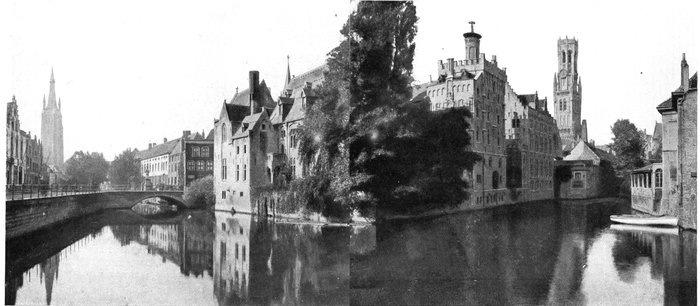
Panorama Seen
from the Quai du Rosaire.
On the left: Church of Notre-Dame and Bridge of
St. Jean de Népomucène. On the right: The Belfry.

The Palais-de-Justice and Palais-du-Franc.
Seen from the Quai des Marbriers.
[Pg 97]

The Quai du Rosaire.
See plan between pp. 88 and 89.
[Pg 98]
Beyond the canal, turn to the right and cross the Placette des Tanneurs
leading to the charming Quai du Rosaire and Le Dyver. The Quai du
Dyver widens, and is planted with fine old trees. Opposite, picturesque
buildings, nestling amidst foliage, are reflected in the still water. The
lofty spire of Notre-Dame dominates all the surrounding country. The Rue
Neuve Bridge is next reached; there the canal (formerly the river Reye),
makes a sharp bend and disappears under the building facing the bridge.
[Pg 99](Beyond the latter, take the Rue Gruuthuuse as far as a new group of remarkable
buildings: Notre-Dame Church, Hôtel Gruuthuuse and St. John's Hospital).
The Hôtel Gruuthuuse.
This pretty structure, situated with Notre-Dame Church in a bend of
the Reye, was formerly the house of the
malt tax-collector. It was leased in the 15th
century to a certain Grutarius who erected
that part of the building overlooking the
Reye, a fine primitive Bruges style gable
of which still remains. The main part of
the building, with its façade, beautiful dormer
windows, and a turretted staircase, was
erected some fifty years later by Louis de
Gruuthuuse. The house had just been completed
when, in 1471, Gruuthuuse received
King Edward IV of England, who had been
driven into exile by Warwick. At the end
of the following century, the family having
become extinct, the mansion was purchased
by Philippe II. In 1628, the municipal mont-de-piété
was installed there, where it remained until 1875, in which year
the city acquired the premises to house the collections of the Archæological
Museum. The mansion has been thoroughly restored in modern times.

Hôtel Gruuthuuse and North Transept of Notre-Dame Church.
Notre-Dame Church.

The lofty spire of Notre-Dame Church dominates the surrounding
country. Its reflection is seen in the calm waters of the "Minnewater"
with that of St. Saviour's (on the left) and the Belfry (on the
right).

Notre-Dame Church. The Nave.
The church of Notre-Dame with its enormous buttressed tower surmounted
by a crocketted spire, is 400 feet high and with its satellites, St. Saviour
and the Belfry, dominates the entire city and surroundings. It is said[Pg 100]
to be the largest brick construction
in existence.
The church is a strange mixture
of restorations, additions and
alterations, which have changed
its character and destroyed its
harmony. The general style is
early Gothic, and reveals its
13th century origin. Two side-aisles
were added to the three original
naves, the first about the
middle of the 14th century, and
the second a century later. The
façade nearest the hospital, flanked
with round turrets, was badly
mutilated. Recent attempts
have been made to restore it,
and at the same time to suppress
certain unbecoming, extraneous
masonry-work, but through lack
of documents, the work was
necessarily carried out in a more
or less hypothetical manner. At
the foot of the gigantic tower and
in striking contrast with its severe nudity is the Radial Gothic Baptistère, an
ancient protruding porch dating from the 15th century, the double arcade
of which was walled up to form a chapel for the font.

The Virgin and Child.
By Michael Angelo.
In the interior one is struck, on entering, by the work of simple juxtaposition
which added a side-aisle to the original one, by opening the arcades
in the old wall and setting new pillars against the ancient buttresses. The
whole of the interior bears marks of
similar treatment. The vaulting of the
naves was reconstructed in the 18th century,
when the present heavy triforium
was built. The small arcades which ornamented
the walls were filled in, but
portions have recently been uncovered
and restored.
The building is 237 feet long and 165
feet wide. An 18th century rood-loft
surmounted with an organ-case separates
the nave from the choir. Above the
organ a triumphal cross (1594) is suspended
from the vaulting. The choir
stalls, like the cathedral, bear the arms
of the Knights of the Golden Fleece, in
commemoration of the 11th. Chapter
held in Notre-Dame in 1468.
The principal interest of the church
lies in the works of art which it contains:
The Virgin and Child by Michael Angelo,
and the Tombs of the last two
Sovereigns of the House of Burgundy:
Charles-le-Téméraire and his daughter
Marie, wife of Maximilian of Austria,
whose mausoleum at Innsbruck, is likewise
a marvel.
[Pg 101]

Tomb
of
Charles-le-Téméraire.
The Virgin and Child (on the altar of the Holy Sacrament, at the end of
the right nave), was the gift of Jean Mouscroen, the donor of the altar,
who paid a hundred ducats for it to the great sculptor in 1514. Its origin,
which was long disputed, is now definitely established (Photo, p. 100).
The tombs of Charles-le-Téméraire and Marie of Burgundy, originally
placed in the choir where they worthily contributed to the decoration of
the sanctuary, were later removed to a closed chapel on the right, formerly
the old Chanterie—reconstituted in 1812 of the écoutète Pierre Lanchals,
who was tortured and beheaded in 1488 by the city burghers. His tombstone
is still to be seen there, but it is the Burgundian tombs which retain
the visitor's attention. Reproductions of the latter abound, and several
European museums (among others, Cluny, Paris) possess plaster facsimiles.
That of Marie is sixty years earlier than her father's, and is greatly superior
both in style and execution. It is the work of Pierre Beckee of Brussels;
the other is by Junghelinck, a native of Antwerp. The sarcophagi are in
black marble with recumbent life-size statues of gilded copper; on the sides
are the enamelled armorial bearings of the numerous domains belonging to
the House of Burgundy. Philippe-le-Beau dedicated this mausoleum to his
mother, who died at the age of 25 in consequence of a fall from her horse.
Later, the remains of Charles-le-Téméraire, killed at Nancy, having been
taken to Bruges, Philippe II had a tomb built for them on the lines of the
first one. At the time of the Revolution the tombs were taken to pieces
and hidden; the parts were reassembled in 1816, thanks to a subsidy of
10,000 francs granted by Napoleon.
The church contains many 17th and 18th century pictures, several remarkable
works dating from the 15th and 16th centuries, paintings, panels
and polyptics, among others an Adoration of the Shepherds by P. Pourbus,
a triptych (first chapel on the left of the Ambulatory), and a Transfiguration
triptych, the central panel of which is attributed to Mistaert (first chapel on
the south side-aisle). Claeyssens, Van Orley, Marc Gheeraerts, Gérard Zeghers
[Pg 102](Adoration of the Wise Men (western wall)) etc.... are likewise represented.
In the Ambulatory, on the left-hand side, is the Gruuthuuse tribune
of carved stone and wood, which used to communicate with the
neighbouring house and was built by Louis de Gruuthuuse in 1472. Several
other tombs are worthy of note, among others, that of Gérard David, the
famous painter of The Unjust Judge; deceased in 1523, he was buried
near the tower staircase. The Sacristy contains some fine 16th century
sacerdotal ornaments named after Marie of Burgundy.
The Cathedral of St. Saviour.

Cathedral of St. Saviour.
This church, with its massive tower, rises abruptly on the left. The
cemetery which formerly surrounded it has been transformed into a public
garden surrounded with railings and heavy modern pilasters. The church
was built in 1183-1228 in the fine primitive Gothic style of the period,
on the site of an ancient sanctuary which was destroyed by fire. Vestiges
of its stone foundations are still visible in the tower. The building was
frequently modified in the course of time, hence an ensemble, in which
figure the various periods of the Gothic style: parts of the transept and the
choir, 13th century; the naves, 14th century; the chevet and apsidal chapels,
15th and 16th centuries; the vaulting, rebuilt in 1732; the four pinnacled
spires of the tower, completed
in 1875. The principal
measurements are as follows:—length:
330 feet;
width: 126 feet; width at
the transept: 176 feet;
height: 96 feet.
Like Notre-Dame (see
p. 99), St. Saviour's is a
typical specimen of the
Flemish churches, as regards
its rich furnishings,
decoration and ornaments
which form a veritable
collection of works of art.
Access is gained through
two side doorways.
Polychrome decoration
(1874-1875 by J. Bethune)
replaced the previous distemper
on the walls, pillars
and ribs of the vaulting,
itself believed to hide a
former decoration of which
no traces remain. A marble
rood-loft of the 17th
century decorated with a
statue of the The Creator
by Quellin the Younger,
and surmounted by an organ-case,
separates the nave
from the choir. The latter
contains curiously carved 15th century choir-stalls, above which are the
armorial bearings of the Knights of the Golden Fleece, a famous order
founded by Philippe-le-Bon in 1429, and whose 13th chapter was held in
the cathedral in 1478.
The numerous paintings by local artists include: The Martyrdom of St.
Hippolytus, a polyptych (veiled), attributed to Dierick Boute, in the third
chapel of the ambulatory. On the left of the transept, in the Chapelle des
Cordonniers is the Tombstone of Burgher Wautier Copman (1387), with its
wonderful, shrouded figure—the finest tombstone that the 14th century
has left us. Opposite is another fine stone, though inferior in style, i.e.
that of Martin de Visch (1453). Various tablets of brass and bronze in
relief, carved wood altar-pieces, tombs of bishops, the shrine of Charles-le-Bon,
etc ..., besides the art treasures in the Salle des Marguilliers and
sacristy, are worthy of note.
[Pg 103]
The St. John Hospital.
The broad gateway of this building, with its low vaulting, opens out in
front of Notre-Dame, from which it is separated by Rue St. Catherine.
A little further on, the old entrance, now walled-up, has retained its small
corner columns and double tympanum, the latter containing a rare specimen
of 13th century decorative art, i.e. two high reliefs depicting: The Death
of the Virgin and The Burial Scene. Unfortunately, the entrance has been
entirely restored in such a manner as to take away much of the interest
which attached to the mutilated structure.

Rue St. Catherine, River Reye, and Hôpital St. Jean.
Here the Rue St. Catherine crosses the Reye, in whose waters are
reflected the gloomy walls, pierced with high windows, and the stepped
gables of the hospital, forming one of the most striking sights of old Bruges
(Photo above).
The building dates from the 13th century and contains a number of antiques
together with the names of the donors. Behind the remarkable old building
facing the street, a new hospital was built in 1856 on the site of the
cemetery; fortunately, the uninteresting appearance of these modern
constructions is hidden by the old buildings.
The hospital includes a small museum, in which are kept the famous
works of Hans Memling, classified under the following names: The Mystic
Marriage of St. Catherine (large folding altar-piece), The Adoration of the
Child Jesus (triptych with oak panels), Sibylle Sambetha (portrait of Mary
Moreel, from the Hospital of St. Julien), The Virgin with Apple (a diptych
of the same origin), and lastly, the famous Shrine of St. Ursula, made
of wood, with double gables, about 34 inches high, 36 inches long, and
13 inches wide, bearing on its sides, framed with archings and separated
by small columns, representations of the six episodes from the Legend of
St. Ursula and the eleven thousand Virgins. [Pg 104](Photo p. 104.)
The two panels of the gables
represent the Saint and the Madonna
respectively; 6 medallions,
attributed to a pupil of Memling,
decorate the roof.
The six side panels represent
the episodes of the legend: 1, St.
Ursula landing at Cologne; 2,
Passing through Basle; 3, Reception
in Rome (the masterpiece of
the series); 4, Return to Basle; 5,
The Massacre of the Virgins at Cologne;
6, Death of St. Ursula (Photo
opposite).
About sixty pictures of great
value complete the Hospital Museum,
together with a number of
relics and pieces of carving. Most
of them are by unknown masters.
Among others, the masterpiece by
Van Oost the Elder, the Meditating
Christian, is especially worthy of
notice. The hospital contains other curiosities, such as the Chapel, the
Dispensary with its ancient furniture and fittings, and the old patients'
ward with its double vaulted nave.
The Béguinage Convent and the Minnewater
Follow Rue St. Catherine (continuation of Rue Notre-Dame, beyond the
Hospital), then take Rue de la Vigne (third on the right) leading to Place de
la Vigne. Immediately on the right, behind the Béguinage Bridge over the
Reye, at the end of Minnewater Lock, is the Renaissance porch (1776) of
the entrance to the Béguinage Convent (photo, p. 105 and sketch below).

A grassy courtyard shaded with slender elms and bordered by low white
cottages, neat and clean like those of a Dutch village, breathes monastic
calm and peace. The tiny church, dating from the beginning of the 17th
century, was built on the site of the 13th century edifice (destroyed by fire).
The Béguinage was founded by Countess Jeanne of Constantinople. The
northern door is the only remaining vestige of the former building. In the
interior are several paintings and tombs
of Nuns ("Béguines"). Adjoining the
house of the Supérieure (Grande Dame),
is a 15th century chapel containing a
carved tabernacle, a brass tablet with a
16th century effigy, and painted vaulting.
On the right, at the other side of the
bridge is the Minnewater (Photo, p. 105
and sketch opposite).
The Minnewater was formerly a navigable
basin constructed at the point
where the Reye enters the city. The
original wooden bridge, flanked with two
towers of masonry, was replaced in 1470
by the present structure. The eastern
tower no longer exists, but the round[Pg 105]
western one still stands at the head of the bridge, and commands a charming
view—often reproduced pictorially—of the town, with its towers and
the Béguinage Convent in the foreground.

Entrance to the Béguinage.
Follow Rue de l'Arsenal, turning left into Rue St. Catherine, at the corner
of which stands the Musée de Peinture (See sketch, p. 104).

The Minnewater. In the background: Tower of Notre-Dame.
[Pg 106]

Entrance
to the
Musée
de
Peinture.
The Musée de Peinture.
This Museum contains a collection of early Flemish masterpieces. At
the entrance are two famous paintings by Gérard David (1498): The Judgment
of Cambyses and The Chastisement of the Unjust Judge. Next come:
The Last Judgment, by Jean Prévost (1525); The Baptism of Christ, a triptych
by Gérard David (1507), with portraits of the donor and his family; The
Virgin and Child, St. George and St. Donatian, with a fine portrait of the
donor, Canon Van der Paele, by Jean van Eyck (1436); a triptych by
Memling (1484); St. Christopher, St. Maurus and St. Giles, with a portrait
of the donor, W. Moreel, his wife, five sons and eleven daughters
(St. George and John-the-Baptist are depicted on the folding leaves); The Last
Judgment, by Van den Coornhuuse, a master-painter of Bruges; two
miniatures, by G. David; two paintings, by Lancelot Blondeel (1545):
St. Luke and The Legend of St. George; also paintings by Pourbus, Clayessens,
Claeys, Van Oost and Van Goyen.
Continue along Rue St.
Catherine, taking on the
right, Rue Vieille-de-Gand
as far as Place de la Porte
de Gand.
The Porte de Gand.
This is one of the city's
former seven gates, of which
only four remain. The
Ghent Gate, a specimen
of the military architecture
of the Middle-Ages, has
like the St. Croix Gate (p.
108), retained much of its
mediæval aspect. To the
right of the gate are
gardens which occupy
part of the ramparts.
[Pg 107]

Quai Vert, seen from the Quai des Dominicains.
Take Rue de la Porte de Gand, opposite the gate, to the modern Church of
Mary-Magdalene, Gothic in style, situated in front of a pretty park.
Take Rue des Ciseaux, which skirts the church on the right, then Rue des
Corroyeurs Noirs, on the left, prolonged by Rue du Cheval.
The latter crosses the Reye at the Quai Vert, which, at this point, is
very pretty (Photo above).
Turn left, into Rue Haute, and return to the Grand'Place.
Second Excursion.
Starting from the Grand'Place, by Rue de la Bride, continued beyond
the Place du Bourg by Rue Haute, cross the Pont du Moulin and follow
Rue Longue, at the end of which is the mediæval Porte St. Croix (photo,
p. 108.) The last two remaining windmills of Bruges are on the ramparts,
to the left.
Follow the ramparts to Rue des Carmes, at the corner of which is the Local
des Archers de St. Sebastien (16th century), with its quaint, slender
tower. Portraits
of Members
of the
Guild are preserved
there,
among others,
those of Emperor
Maximilian
and
Charles II of
England.
Continue
along Rue du
Persil which[Pg 108]
ends at Quai de la Poterie; take the latter on the left, as far as the Hospice
de la Poterie.

Porte de St. Croix, and the Windmills on the Ramparts.
La Poterie.
This is both a church and a home for the aged poor. Its gabled façades
were charmingly restored by Ch. Verschelde, chief initiator of the movement
for the renovation of Bruges Architecture, deceased in 1881.

Choir of the Chapelle de l'Hospice de la Poterie.
[Pg 109]

Chapel of the Virgin, in the Chapelle
de l'Hospice de la Poterie.
The polychrome decoration
of the interior of the
church recalls that of the
Frauenkirch at Nuremberg.
The nave dates from 1358;
the choir, marble rood-loft
and other portions are 17th
century. The tombs of Nicolas
Despars (1597) and
Jean de Beer (1608), and
the rich Treasury in the Sacristy
are interesting.
The Museum (parlour,
refectory, corridors) contains
ancient furniture, ivory carvings,
antiquities, rich Flemish
tapestries, and a fairly
large collection of pictures.
The Séminaire.
The Seminary, situated
immediately beyond the Poterie,
is the old Abbey of the
Dunes, which was reconstructed
at Bruges in 1623-1628.
The church, rebuilt in
1775, replaced the original
edifice founded in the 12th
century between Furnes and
Coxyde, and destroyed by
the Iconoclasts in 1556.
Since the Revolution, it has been successively a hospital, school, lycée,
warehouse, and athenæum. Today it is a diocesan seminary.
The seminary contains a collection of portraits of the bishops and abbots
of Bruges and Ypres, also the famous Visitation, by Albert Dürer, in which
that great master displays to the full his exquisite talent. It is the only
piece of sculpture by Dürer in the country.
Continue along Quai de la Poterie as far as the Pont des Carmes opposite
the street of the same name. Cross the bridge and take Rue de la Cour de
Gand leading to the small Place Memling, in which stand a quaint STATUE
of the artist and the ancient Hôtel des Orientaux.
In the continuation of Rue de la Cour de Gand, beyond Place Memling, is
one of the two last remaining wood-panelled
houses of Bruges. Place Jan
van Eyck [Pg 110]
[Pg 111]
[Pg 112](Photo and sketch, p. 110) is
next reached.
Here stands the heavy bronze statue
of Jan van Eyck, the gifted inventor of
oil painting.
In front, is the Academy or Poortersloge
(14th century), formerly the
House of the Burghers, then the meeting-place
of the White Bear Company, whose
emblem may still be seen in the corner
of the building which overlooks the Rue
Espagnole. It is the Beertje van Loge, the oldest "burgher" of Bruges,
just as the Mannekenpis is the oldest "burgher" of Brussels. However,
the "Bear of Bruges" is the older of the two (1417).
The building was used as an Art Gallery from 1719 to 1898. Since then
it has been entirely rebuilt in the original style, with a slender tower facing
the Rue de l'Outre, and now contains the State Records.
On the right of the square stands the ancient Tonlieu, with its pretty
façade, large gable and porch, the whole artistically restored in 1880. The
Municipal Library, comprising some 15,000 volumes, is now housed there.
The collection includes a series of incunables printed by Colard Mansion of
Bruges (15th century), 562 MSS, a collection of epitaphs, and the Steinmetz
Collection of drawings and engravings.
Take Rue de l'Académie, facing which, on arriving at the Place du
Theatre, is the Maison des Génois, a souvenir of the great prosperity of
the city during the Burgundian epoch.
The tympanum of the door is decorated with a St. George and Dragon.
This ancient warehouse of the rich
Italian merchants is now a café.
In the middle of the Square is the
Theatre and behind it, the gloomy
Maison des Tonneliers.
Tourists should here take a stroll
through the old picturesque streets of
this quarter, especially Rue des Aiguilles
and Rue au Beurre, which
lead to the Church of St. Jacques.
The Church of St. Jacques.
Irregular in style, this church has
a square tower with a pyramidal roof.
Erected in the 13th century and
enlarged in the 15th, it bears the stamp
of both periods. Especially noticeable
are the irreparable marks of
restorations carried out in defiance of the principles and character of the
original styles. The church was sacked during the religious troubles of
the 16th century. The most unfortunate alterations were those carried
out at the end of the 17th century. In 1820 a ceiling was added, cutting
off the upper portion of the columns and pillars. Attempts have since
been made to remedy these defects.
The church contains many valuable works of art, the most important of
which is The Tomb of Ferry de Gros, treasurer of the Order of the Golden
Fleece, deceased in 1544, and of his two wives, Philippine of Wiebaut and
Catherine of Ailly. It is one of the very few surviving specimens of 16th
century Flemish art, and remained for a long time in a walled-up chapel
used as a store-room. In 1864, the chapel and tomb were completely restored.
The figures are recumbent, on two superimposed stones, Ferry and his first
wife being uppermost. The other stone is by far the more remarkable
of the two. Attempts have been made to restore the original polychromy
of the monument. The tomb and the Chapel form a very harmonious
and decorative whole.
Among the paintings are: on the altar in the Chapel of Souls, a reredos
in three parts. It represents St. Cosmas and St. Damian, and is considered
to be Lancelot Blondeel's greatest masterpiece. In the same chapel: a
triptych, by Peter Pourbus (1556), The Virgin of the Seven Afflictions,
and a Resurrection, by the same painter (1578). In the south aisle: The Presentation
of the Virgin, one of the finest works by Van Oost the Elder (1655).
On the altar, in the northern nave: The Coronation of the Virgin by Albert
Cornelis (1520), the only work of this master, and a fine Triptych, by Jan
Mostaert (1474-1555).
In the chapels are copper and brass tablets. The carved wood pulpit,
rood-loft and choir-stalls are in decadent Renaissance style (17th century).
Behind the high-altar is a three-storied marble tabernacle, dating from 1593.
The belfry contains some very fine bells, the oldest of which was cast in
1525.
On leaving the Church of St. Jacques, the tourist may either turn left over
the bridge and along Rue des Baudets, as far as the Porte d'Ostende (photo
below) or return to the Grand'Place, by Rue St. Jacques, on the right.
Fourth Day.
FROM BRUGES TO POPERINGHE, NEAR YPRES.
Lunch at Dixmude, but provide luncheon baskets, in case of need.
Leaving the Grand'Place, Bruges, via the Place du Marché-aux Œufs,
take Rue de la Monnaie, on the left, then Rue Nord du Sablon, and beyond the
station and level-crossing, Rue du Maréchal. Go through the Porte Maréchale
which, like the Ostend Gate, bears traces of its 17th century restoration
(Photo, p. 113).
At the fork, 1 km. further on, take the right-hand road to St-André. Pass
through same, then through Varssenaere, Jabbeke, Westkerke and
Ghistelles. Beyond Ghistelles (level-crossing), take the Ostend-Thourout
road, on the left. Pass through Moerdijck (24½ kms.), and on reaching the
hamlet of Halve-Barreel, turn to the right.

Maréchale
Gate,
by which
the tourist
leaves
Bruges.
At the first group of houses turn to the right, then to the left at the first fork.
At the first house of the hamlet of Leugenboom (3½ kms.), take the foot-path
on the right, from which, 150 yards to the left, can be seen the Pommern or
Leugenboom Battery, at the edge of the wood. This battery comprises[Pg 113]
a 15in. long range gun, which did most of the bombarding of Dunkirk. The
gun, protected by armour, is mounted on a steel bridge having a pivot in
front, the rear part of the gun travelling
along a circular rail-track in a concrete pit
nearly 70 feet in diameter. The gun was
manœuvred by means of electric motors. On
either side are large shelters in reinforced
concrete. In front of and below the platform
there was an electric generator group.
A large shelter of reinforced concrete, on the
right, was probably the Post of Commandment.
There is a dummy gun emplacement
further on.

"Pommern"
or
"Leugenboom"
Battery,
near
Leugenboom
Hamlet.

Concrete Shelter at St. Pierre-Cappelle.
Return by the same road to Moerdijck, turn left beyond the bridge, pass[Pg 114]
through Moere (2 kms.),
and after crossing the
light railway, take the
road on the right which
follows the railway to
Leke village (5½ kms.).
Beyond the ruins of the
church, take the right-hand
road to St. Pierre-Cappelle
(4 kms.), whose
church is in ruins.
Continue straight along
the Nieuport road, noticing
the many observation-posts
and concrete
shelters. Throughout the
region crossed by the itinerary, on both sides of the Yser, the ground has been
completely devastated by trenches, shelters and bombardments. The villages have
vanished. Today these places are the resort of pilgrims. Spermalie (2 kms.)
is next reached.
Beyond the bridge, at the fork, take the right-hand road (in bad condition)
to Mannekensvere.
A few heaps of stones and débris are all
that remains of Mannekensvere. To visit St.
Georges, cross the Yser by a small wooden foot-bridge,
near the place where the Pont de l'Union
used to stand. (It is impossible for vehicles to
cross the river). Between the Yser and St.
Georges, follow a "boyau" (by-trench) to the
first Belgian and German lines, marked by
many concrete shelters pierced with loop-holes.

The Site of Mannekensvere village.
Mannekensvere was situated on the right bank of the Yser. The Pont de
l'Union, which crossed the Yser 3 kms. from Nieuport, connected it with
St. Georges, situated a little further back, on the left bank, along the Nieuport-Bruges
Road. These two villages and the bridge were among the principal
targets of the Germans. On October 18, 1914, Mannekensvere, an advance-post
of the Belgian 2nd Division, was carried by the Germans, but recaptured
shortly afterwards by the Belgian 7th Infantry Regiment (Major
Evrard). Unfortunately, the German heavy artillery made the position
untenable on the following day, and Major Evrard was forced to re-cross[Pg 115]
the Pont de l'Union, which he blew up. St. Georges, on the contrary,
was captured only on October 23, after the crossing of the Yser by the
enemy, and the loss of Groote-Hemme Farm which covered it from
the south.
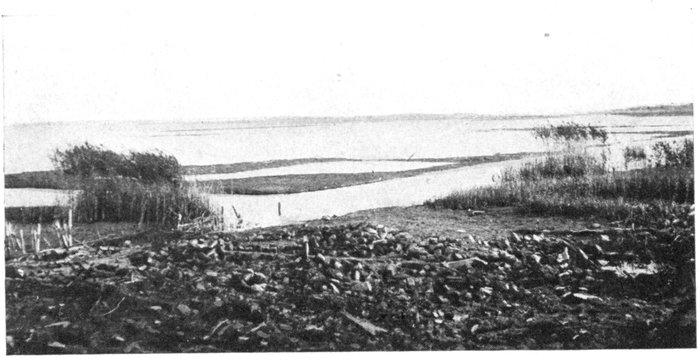
The
Inundations
near
Dixmude.
Return to Spermalie, where turn to the right.

Temporary
foot-bridge
across
the
inundations.
The whole of the region now about to be crossed was flooded throughout
the war. Today, the waters have receded, leaving it covered with reeds.
Schoore (1 km.), completely razed, is next reached.
Schoore was situated slightly to the right of the Yser, on the road to
Bruges. The Belgian 1st Division had its advance-posts there. The village
was captured on October 18, 1914, by a battalion of the German IIIrd
Corps, after a four hours' bombardment.
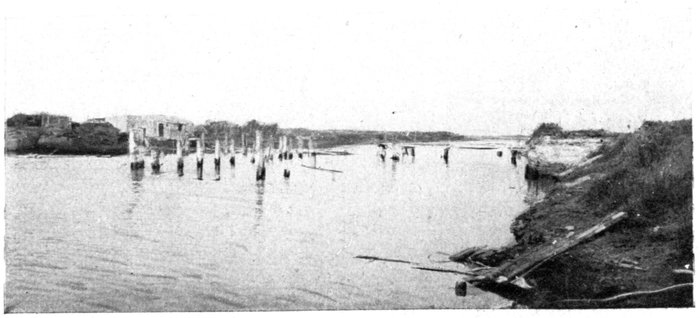
The
Pont de l'Union,
between
St. Georges
and
Mannekensvere.
[Pg 116]
Cross the Yser at Schoorbakke (2 kms.)
This village had a bridge across the Yser, at the end and to the west
of the great bend in the river, beginning at Tervaete.
This important strategical point was early threatened by the enemy.
After the furious combats of October 15-22, the grand assault was launched
on the night of the 22nd. A battalion of the Belgian 4th Infantry Regiment,
though practically hemmed in by the enemy, defended it heroically,
and only evacuated the position at dawn on the 23rd (see p. 12).
Between the Yser and the shelters bordering its left bank, a foot-path on the
right leads to Groote-Hemme Farm (1 km. 300.)
Keep straight along the road. The first road on
the left leads to Stuyvekenskerke (1½ kms.) of
which only a few broken walls remain.
To the left of the church there is a temporary footway
along the road; today the latter is recognizable
only by the stumps of the trees which formerly
bordered it. The footway leads to the site on which stood the Château
of Vicogne, and further on, to Tervaete (Photo, p. 117.)
From this village, the Yser describes a wide curve towards the west
which ends at Schoorbakke. At Tervaete, a bridge spanned the Yser. From
the right bank the enemy were able to enfilade and even attack the Allies'
defences on the left bank, in the rear, and effect a crossing of the river at
that point. This explains the frequency and fierceness of the German
attacks on Tervaete, which was first lost then recaptured on October 22,
1914, being finally captured by the Germans the next day (See p. 12).
From Stuyvekenskerke, return to the road previously followed, turning left
towards Pervyse. Shortly before reaching Pervyse are the remains of an
elevated footway, which formerly crossed the inundated ground. After
crossing what used to be the permanent way of the Dixmude-Nieuport railway,
the village of Pervyse is reached (3½ kms.) The railway embankment
formed the boundary of the inundated area, and was fortified. Shelters and[Pg 117]
graves are still to be seen all the way along. There was an observation-post
on the top of the railway-station, to the left of the road.
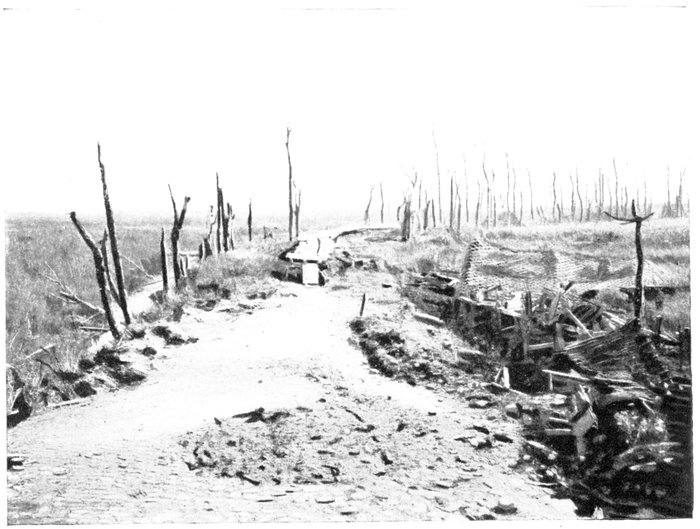
Temporary Bridge at Tervaete, on the impassable road to Stuyvekenskerke,
in 1919.
Pervyse, in ruins, was made famous by the heroic resistance of the French
Marines who beat off the enemy's fierce onslaughts of October and
December 1914.
The houses bordering the road at the entrance to the village were turned
into machine-gun blockhouses, thus barring the way.
Beyond the church is a crossing; the road on the right leads to Ramscappelle
(4½ kms.) which played an important part in 1914. On October 30, 1914,[Pg 118]
a fierce German thrust ended in the capture of the village—already on the
point of being inundated—from the Belgian 5th and 6th Infantry Regiments.
The loss was one of the greatest importance, as no lines of resistance had
been prepared in the rear. The recapture of Ramscappelle was therefore
an indispensable if very difficult operation. (See p. 15.)

Caeskerke Church (August 1917).
The left-hand road leads to Dixmude. Caeskerke (5½ kms.), a station
on the Dixmude-Nieuport railway, is next reached. The Headquarters of
Admiral Ronarc'h were established there in October 1914, and it was
this fact which caused it to be bombarded by the Germans, whose
shells quickly reduced it to ruins.
Beyond Caeskerke, cross the Yser; before reaching the bridge, on the left,
along the riverside, is a trench with numerous shelters, known as the "Boyau
de la Mort" (Death Trench). It was enfiladed by machine-guns posted
in the flour-mill on the opposite bank of the Yser (on the right, near the
bridge), which the Germans had converted into a fortress. (Photo p. 124.)
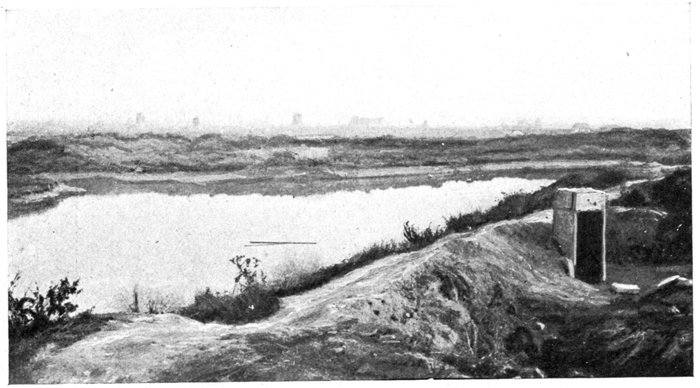
The "Boyau de la Mort" (Death Trench). See p. 19. In the background: Dixmude.
The tourist next reaches Dixmude (2½ kms.), arriving at the Grand' Place.
[Pg 119]
Dixmude was a small ancient town of some 4,000 inhabitants, situated
in the midst of fields on the right bank of the Yser.
It was entirely destroyed. Of the town's monuments and buildings,
traces of the parish-church of St. Nicholas only remain (on the left side of the
square). The chevet dated from the 14th century, the rest of the building
being early 16th century. The church contained a magnificent rood-loft
of finely carved white stone (1540). Above the high altar was a fine Adoration
of the Wise Men, by Jordaens (1644). The rich ancient furnishings
comprised: a marble font with a bronze cover (1626), choir-stalls, pulpits,
a "Calvary" altar, a carved oak organ-loft, wrought copper chandeliers,
candlesticks, etc.
From the heap of stones and débris—the remains of the church tower—there
is a good view of the ruined town. In the same square stood the
Hôtel-de-Ville, Gothic in style, built about 1870. It was entirely razed
(Photo below).

Dixmude, seen from the ruined Church (1919).
[Pg 120]

Dixmude. The Hôtel-de-Ville, before the war.
The left-hand road leads to the bridge over the Handzaeme Canal, one of
the most picturesque parts of Dixmude. Close by, to the left of the road,
stood the Béguinage, comprising some twenty houses grouped around a
small chapel, and a fine garden. The place is now overrun with weeds.
The Defence and Capture of Dixmude.
Dixmude was the scene of most desperate fighting from October 15 to
November 10, 1914. The French Naval Brigade—6,000 men commanded
by Admiral Ronarc'h—with a brigade of the Belgian 3rd Division under
General Meiser, and a few battalions of Senegalese troops, held out heroically
for a month against enemy forces six times more numerous and supported
by masses of heavy artillery.
On October 16, along the roads encumbered with refugees from the region
of Thourout, the Marines, in their retreat from Melle to Ghent, reached
Dixmude in the pouring
rain, accompanied by the
Belgian batteries under Major
Pontus. Under enemy pressure
the advanced positions
of the town were abandoned.
At that time, the river
formed the only line of defence
against the enemy
thrust, there being no trenches,
shelters, or wire entanglements.
In spite of great fatigue,
due to the forced marches,
the Marines and Infantry,
with the help of some[Pg 121]
companies of Belgian Engineers, organised defences in the vast plain.
Trenches were made round the town, 1 km. beyond its outskirts, whilst
the bridges, footways and dikes of the Yser Canal were fortified at the
same time.

The Chevet of the church before the war. (Photo E. Thill.)
The defences of the bridgehead of Dixmude were divided into two sectors,
separated by the Caeskerke Road.
Having no aeroplanes or heavy artillery, the 6,000 French Marines, with
5,000 Belgians of the Meiser Brigade—11th Regiment (Col. Leermans) and
12th regiment (Col. Jacques)—were attacked by three German Army
Corps.
After an unsuccessful feint attack on October 16-17, the Germans, having
meanwhile received reinforcements and siege artillery from Antwerp,
renewed their assault with increasing violence.
On the 20th, at 11 a.m., the first big shell fell in the town. In conformity
with the Burgomaster's orders, the civilians left the town, except the
Carmelite Nuns and a few other persons, who were forced to leave a few
days later.

A street in Dixmude, in 1918.
[Pg 122]

The Yser at Dixmude, before the war. (Photo Nels.)
The first shells fell on the church, which was burnt. Fires broke out
everywhere and soon destroyed the town. The troops stoically awaited
the attack, which came simultaneously from the north, east and south.
The assaulting columns were in massed formation, sixteen lines deep.
They were literally mown down, and after a desperate struggle their scattered
remnants were thrown back on their starting positions.
The attack continued on the following days, without appreciable enemy
gain. Whenever, by force of numbers, they penetrated the defences,
reserve sections of Marines drove them back at the bayonet's point.
Dixmude was none the less in imminent danger. German troops crossed
the Yser at Tervaete, and slipped along the left bank of the river with the
intention of turning the position. In the thick of the battle and in spite
of the incessant frontal attacks, Admiral Ronarc'h dispatched two battalions
to the threatened point. Although the
men were "half-dead with the cold and
lack of sleep", a front was improvised between
the Yser Canal and the embankment
of the Nieuport-Dixmude railway. The
manœuvre was a difficult one, but by prodigies
of heroism the new line stood firm and
became fixed.
On the 24th, a bombardment of unprecedented
intensity was opened on the town
and its defences, including the station of
Caeskerke, where the Admiral's headquarters
were situated, but the defenders held their
ground unflinchingly under the terrible deluge
of flying splinters. Towards evening,
the enemy made a tremendous effort
against the bridgehead of Dixmude. Eleven
assaults in the north and north-east[Pg 123]
sector, and fifteen assaults in the south-east sector were successively
repulsed. The German dead accumulated in heaps, right up to the Allies'
trenches. The struggle continued hand-to-hand until midnight, in pitch
darkness, the men floundering blindly in the mud.

The Yser at Dixmude, after the war. (See opposite.)
Exhausted by their tremendous efforts the enemy gave way. Dixmude
was still inviolate, but on the morrow, as soon as the morning mists had
risen, the bombardment began again along the whole line. Little by little
the town fell into ruins.
On the night of the 25th, a company of German infantry managed to
slip into the town. About a hundred of them crossed the bridge-road
and in close formation made a dash for Caeskerke, with fife and drum
at their head. That the men were drugged, explains their foolhardy
exploit. A few prisoners, including several Belgian doctors, Commandant
Jeanniot and some marines were captured. Held up soon afterwards,
the Germans attempted to get back to their lines, shooting most
of their prisoners at dawn. The doctors and a quarter-master alone were
spared, being eventually delivered by a section of French Marines.
The troops under Colonel Jacques, exhausted by the struggle, were relieved
by two battalions of Senegalese and a battalion of the Belgian 1st
Line Regiment.
Keeping up their daily bombardment, the enemy now directed their
main effort between Nieuport and Dixmude. However, they were held
by the inundations which soon spread southwards. Moreover, the ceaseless
rain had transformed the ground into a veritable sea of mud, which
gradually invaded the trenches. Shivering with cold and fever, and up
to their knees in slime, the Marines still stood firm.
The Capture of Dixmude.
On November 10 the Germans, infuriated by their repeated checks,
attacked again with overwhelming forces. Part of the defences in the
southern sector, between the railway and the Eessen road, held by
Belgian infantry, gave way beneath the shock, bringing about the fall of[Pg 124]
the sectors on either side, held by the Senegalese troops. The line was
pierced in the centre. The enemy swarmed through the breach, crossing
the Handzaeme Canal to the north, while to the south, in the direction of
the cemetery, they attacked the companies of Marines who continued to
resist desperately. The Germans entered the town, the fight continuing
from street to street and house to house, with countless surprises and
ambuscades. Unarmed prisoners were made to march in front of the
assailants, who proceeded to attack the positions on the Yser. Amongst
them was Naval-Lieutenant Sérieyx, who, wounded in the arm, had just
fought with his men to the last cartridge.

The
Minoterie.
(Flour
Mill.)
On being ordered by the German Commandant to indicate the fordable
places in the river, one of which was only some fifty yards away, the French
officer, to gain time, made a complicated sketch of the position, placing
himself and his men the while in front of the Germans. Becoming impatient,
the German ordered the Frenchmen to call on the defenders of the
canal to surrender.
"But how can you expect them to surrender", was the calm rejoinder,
"seeing that there are ten thousand of them". In reality, they numbered
about two hundred.
At this point, heavy rifle fire to the north drew the attention of the enemy
elsewhere, seeing which, the wounded officer, exhorting his men to follow
him, jumped into the river and swam over to the other side.
When night fell, the bridges and flour-mill—a powerful blockhouse
in reinforced concrete—were blown up, the whole of the Franco-Belgian
troops having meanwhile been withdrawn behind the embankment of the
Yser Canal, which they held
under gunfire. The Germans
sought to organise
the ruins of the unfortunate
town, whose destruction
was now being completed
by the Allies' artillery.
The inundations reached
Dixmude, forming an impassable
barrier for the
enemy.
On November 26, 1914,
the French Naval Brigade,
which later further distinguished
itself on other fields[Pg 125]
of battle, and whose flag was eventually decorated with the Légion d'honneur
(fourragère), was mentioned in the Army Orders, in the following terms:
Gave proofs of the greatest energy and devotion in the defence of a most
important strategic position.

Admiral
Ronarc'h
saluting
the Flag
of the
French
Marines.
Until October 1918, the enemy's front lines followed the banks of the
canal and the Death Trench, dominated by the ruins of the flour-mill
situated upstream from the destroyed bridge-road. For four years, violent
raids and bombardments kept this sector, successively held by French
Marines, Territorials, Zouaves, and Belgian Infantry, in a perpetual state
of activity.
Finally, in September 1918, during the great Liberty Offensive, the Belgian
4th Division attacked the banks of the Yser Canal, turned Dixmude
from the east, and in a single rush reached the banks of the Handzaeme
Canal. On September 29, Dixmude, reduced to a chaotic waste covered
with shapeless masses of débris and tangled barbed wire, and cut up
entirely with trenches, was retaken by the Belgians.

Watching
a Review
of the
French
Marines.
[Pg 126]
On January 25, 1920, in the presence of King Albert, President Poincaré
conferred the French Croix de Guerre on Dixmude, with the following
mention.
"Won undying fame in the first days of the War by heroic, never-to-be-forgotten
combats. Proved herself worthy of this glory by the fortitude
with which she daily supported bombardments and fires, confident that her
sacrifices were helping to save the Country and the Common Cause."
From the canal, return to the Grand'Place and take the Roulers Road,
turning into the first by-road on the left; 3 kms. beyond the level-crossing, leave
the Clercken Road leading to Houthulst Wood, on the right, and keep straight
on to Eessen (3½ kms.) The belfry of the
ruined church was long used by the Germans as
an observation-post (Photo above).
In front of the church, turn left and cross the
railway. The road leads to Vladsloo (large
German cemeteries). Behind the church, turn left.
On reaching the high road, turn left and enter the
village of Beerst (5 kms.)
Beerst and, further north, Keyem served as
advance posts in October 1914 to the Belgian
4th Division which was then defending Tervaete. Violently attacked on
October 18, they were lost and retaken, being finally abandoned on the
morrow. In a desperate effort to save Beerst, the French Marines captured
it twice at the point of the bayonet, covering themselves with glory,
but all to no purpose. Beerst was completely ruined. Many cellars, transformed
by the Germans into fortified shelters, may still be seen.
On reaching the road to Dixmude, turn left, pass through Dixmude (3½ kms.)
and leave the town by the road previously followed. Take the first road on
the left to Loo (1½ kms.)
This small, ancient town is situated on the banks of the Yser canal.
Its large 15th-16th century Gothic church, formerly an abbey, contains
paintings and several fine tombs.
Keeping straight ahead beyond the Grand'Place, in which stands the Renaissance
Hôtel-de-Ville, the tourist will notice, immediately on the left, an Old
Gate (Westpoort), a vestige of the ancient fortifications. A sycamore
tree, probably some four or five centuries old, near by, is said by the inhabitants
to have been used by Julius Cæsar as a picket for tethering his
horse.
[Pg 127]

Loo.
1. Westpoort Gate, and
the "Julius Cæsar"
Sycamore Tree;
2. The Grand'Place.
The Hôtel-de-Ville
(on the right), and the
ruins of the Church.
Return to the Grand'Place,
turn to the right,
and cross the Yser.
Reninghe (5 kms.)
(razed) is next reached.
To the right of
the Square, take the
street along which
runs the local railway,
leaving the
church on the left.
Before turning, the tourist will notice just beyond the church a small château
dating from 1648 (Photo below). Follow the railway as far as Oostvleteren
(4 kms. 300), where
cross the Furnes road
to reach Westvleteren,
1 km. 300
further on. Turn to
the left, beyond the
church of the latter village,
keeping straight
on to Poperinghe
(10 kms.), via Eikhock.
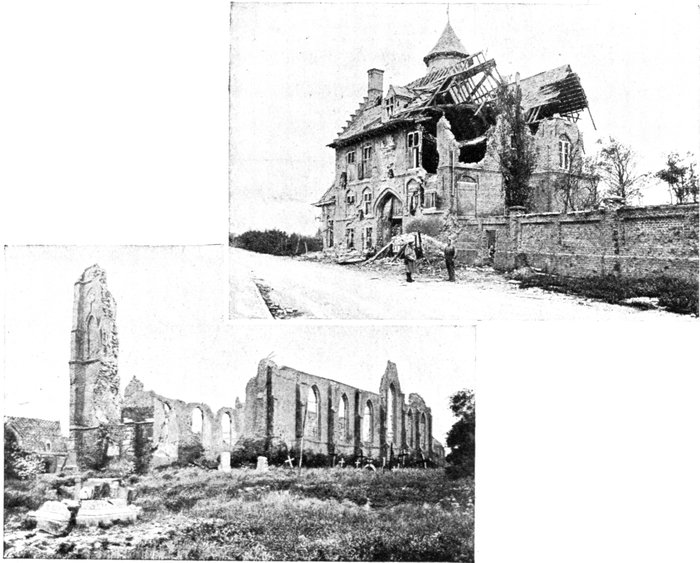
Reninghe.
1. The 17th century
Château;
2. Ruins of the
Church.
[Pg 128]
- A
- Aachen Battery, 56, 57
- Adinkerke, 36
- Antwerpen Battery, 57
- Augusta Battery, 83
- B
- Beerst, 126
- Beseler Battery, 57
- Blankenberghe, 74
- Bruges 85, 113
- C
- Caeskerke, 118, 122, 123
- Cecilia Battery, 58
- Clercken, 126
- Coxyde, 37
- D
- Dixmude, 118, 126
- Dudzeele, 85
- Duinbergen, 84
- Dunkirk, 24, 32
- E
- Eessen, 126
- Eikhock, 127
- F
- Freya Battery, 83
- Friedriechsart Battery, 82
- Furnes, 38, 41
- G
- Ghistelles, 112
- Groden Battery, 75
- Groote-Bamburg Farm, 53
- Groote-Hemme Farm, 115, 116
- H
- Hafen Battery, 74
- Halve-Barreel, 112
- Herta Battery, 74
- Heyst-sur-Mer, 83, 85
- Hindenburg Battery, 70
- Hondschoote, 34, 35
- J
- Jabbeke, 112
- Jacobinessen Battery, 72, 73
- K
- Kaiserin Battery, 74
- Kaiser Wilhelm II Battery, 84
- Kanal B Battery, 83
- Knocke-sur-Mer, 84, 85
- L
- La Panne, 36, 37
- Le Coq, 74
- Leke, 114
- Leugenboom, 113
- Lombartzyde, 43, 53
- Loo, 126, 127
- M
- Mannekensvere, 45, 114, 115
- Mariakerke-Bains, 58
- Middelkerke-Bains, 57
- Mittel B Battery, 75
- Moerdijck, 112, 113
- Moere, 114
- N
- Nieuport, 42, 51
- O
- Oost-Dunkirk, 42
- Oostvleteren, 127
- Ostende, 59, 68
- P
- Pervyse, 116, 117
- Pommern Battery, 113
- Poperinghe, 23, 127
- R
- Ramscappelle-lez Bruges, 85
- Ramscappelle (near Nieuport), 117, 118
- Reninghe, 127
- Rosendael, 33
- S
- Saint-André, 112
- Saint-Georges, 46, 114, 115
- St Pierre Cappelle, 114
- Schoorbakke, 116
- Schoore, 115
- Spermalie, 114, 115
- Steenstraate, 49
- Stuyvekenskerke, 117
- T
- Tervaete, 116, 122
- Tirpitz Battery, 58, 63, 64
- V
- Varssenaere, 112
- Vladsloo, 126
- W
- Wenduyne, 74
- Westende, 54, 55
- Westkerke, 112
- Westvleteren, 127
- Wulpen, 42
- Z
- Zeebrugge, 75, 81
- Zeppelin Battery, 75
- Zuydcoote, 34

[Pg 129]
MICHELIN DURING THE WAR
THE MICHELIN HOSPITAL
When the Great War broke out, Michelin at once converted
an immense new four-storied warehouse into an up-to-date
Hospital, with Operating Theatre, X-Ray, Bacteriological
Laboratory, etc. Seven weeks later (September 22, 1914)
Doctors, Dispensers, Nurses, Sisters of Mercy, and auxiliaries
were all at their posts. The first wounded arrived the same
night. In all, 2,993 wounded were received.
All expenses were paid by Michelin.
The story of how Michelin did "his bit" during the war
is told briefly and simply in the illustrated booklet, "The
Michelin Hospital," sent post free on application.
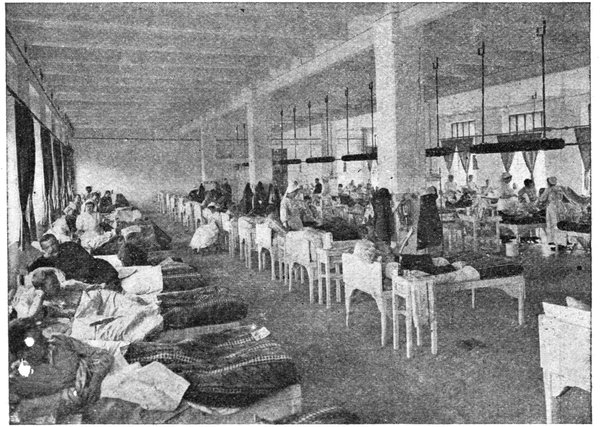
A VIEW OF ONE OF THE WARDS
MICHELIN & Cie., Clermont-Ferrand, France.
MICHELIN TYRE Co., Ltd., 81, Fulham Road,
London, S. W. 3.
[Pg 130]
THE
MICHELIN
TOURING OFFICE

A VIEW OF THE MICHELIN TOURING OFFICE
Open to all Motorists seeking information and
advice regarding Tours
The MICHELIN Touring Office saves the intending Tourist
time and trouble, and generally assists him in mapping out his
Tour free of charge, and irrespective of the make of Tyres he uses.
Send us a rough draft of your next proposed Tour and we will
prepare a complete and detailed itinerary and forward it on to
you, within three or four days.
MICHELIN TOURING OFFICE
81, FULHAM ROAD, LONDON, S. W. 3. and
99, BOULEVARD PEREIRE, PARIS, XVII.
Telephone: Kensington 4400. Telegrams: "Pneumiclin, London"
[Pg 131]
MICHELIN ROAD MAPS
SCALE 1·200,000 OR 3·15 MILES TO THE INCH.
| MAP OF |
GREAT BRITAIN |
31 |
Sheets |
| — |
FRANCE |
48 |
— |
| — |
BELGIUM |
3 |
— |
| — |
SWITZERLAND |
4 |
— |
| — |
SPAIN |
13 |
— |
MICHELIN TOURING MAPS can be obtained from
MICHELIN Stockists and booksellers in Great Britain,
France, Belgium, Switzerland and Spain, from MICHELIN
& Cie., Paris, and from
MICHELIN TYRE CO., LTD.
81, FULHAM ROAD, LONDON, S. W. 3.
Added table of contents.
Used the mid-dot (·) rather than the full stop for all decimal points.
Silently corrected simple spelling, grammar, and typographical errors.
Retained anachronistic and non-standard spellings as printed.


 Arcades. Tel. 1·89.
Arcades. Tel. 1·89.









































